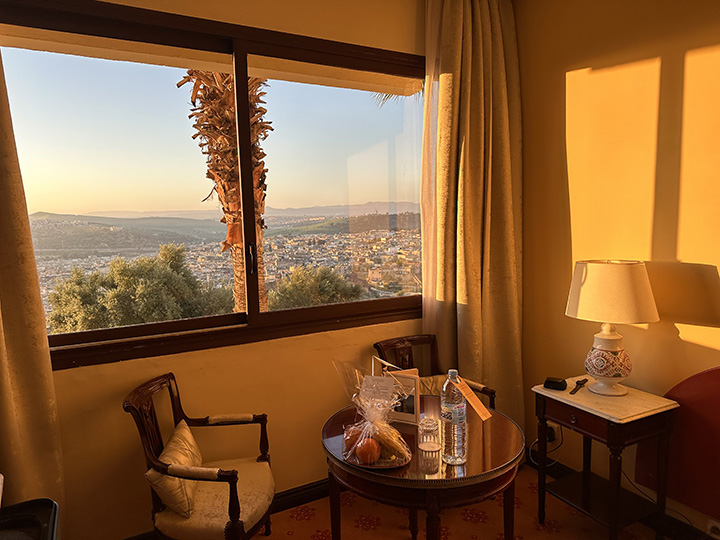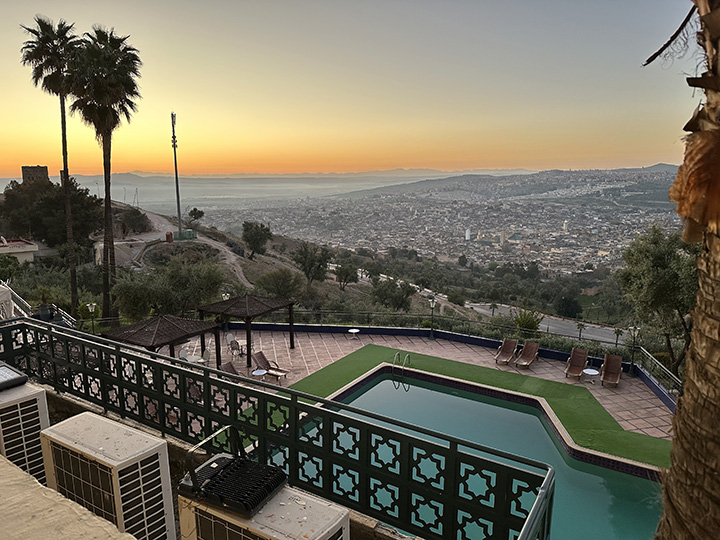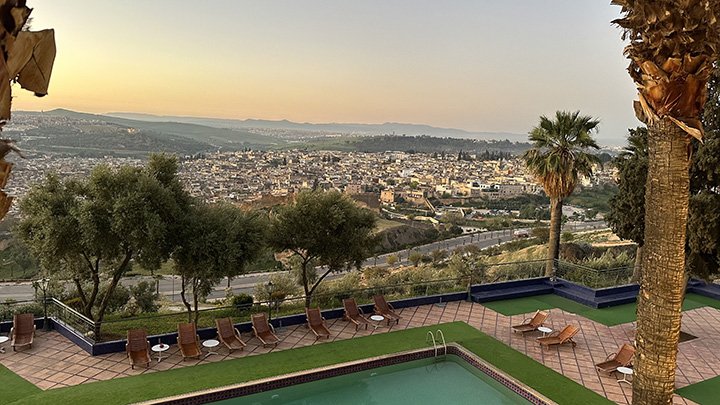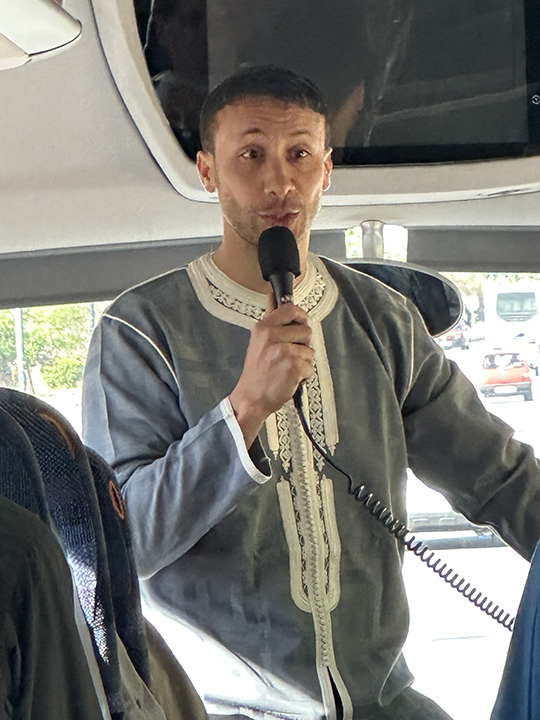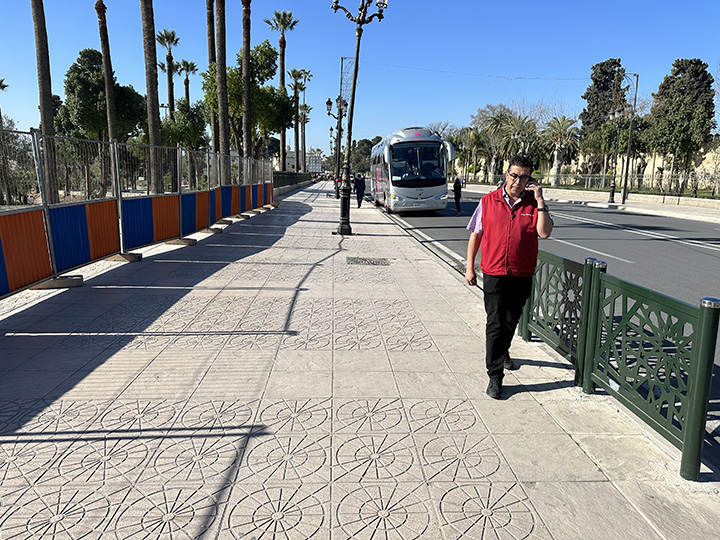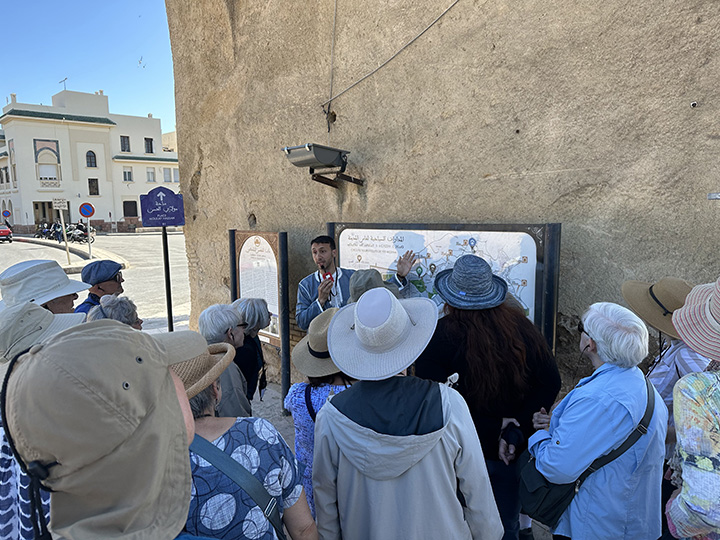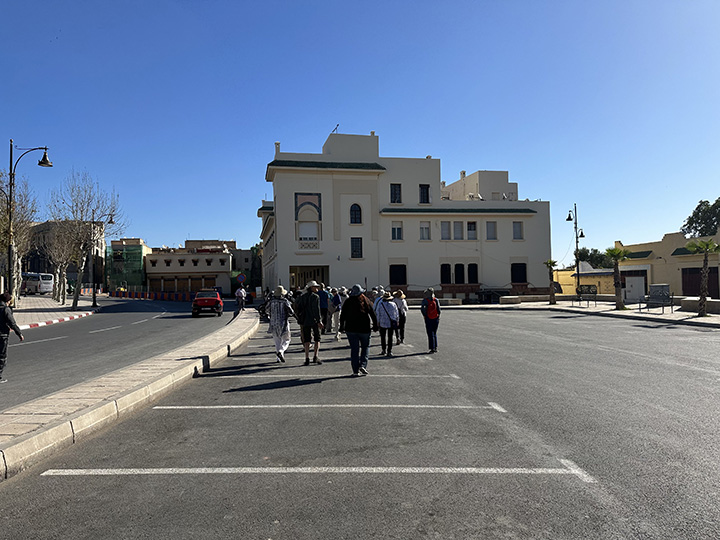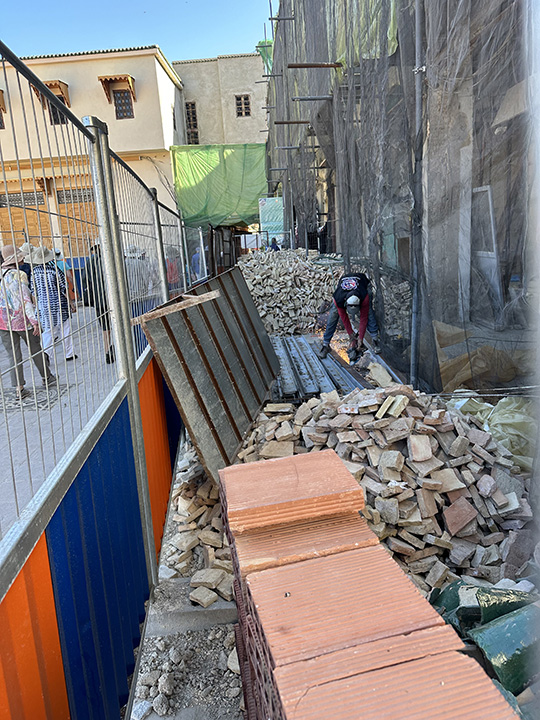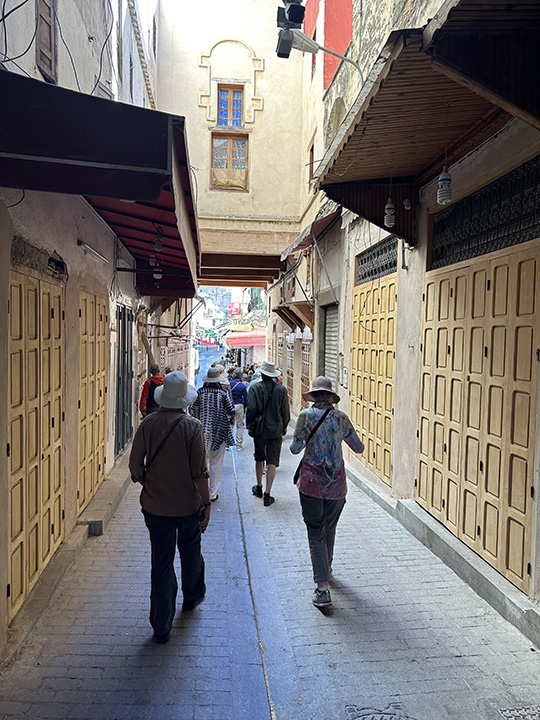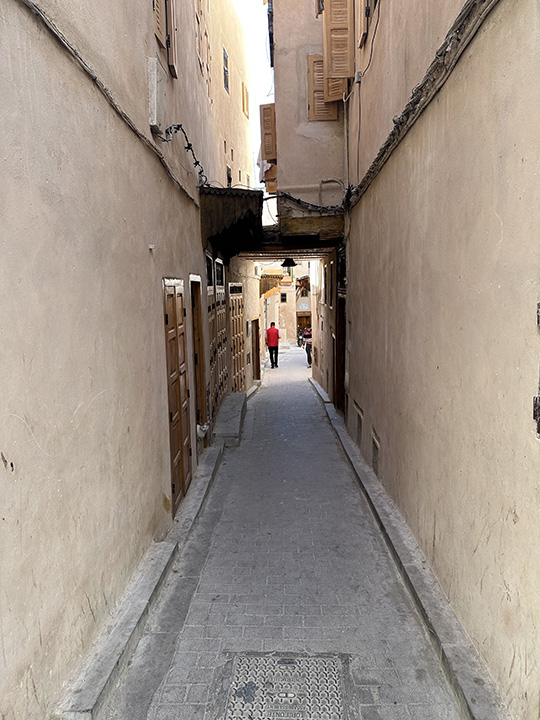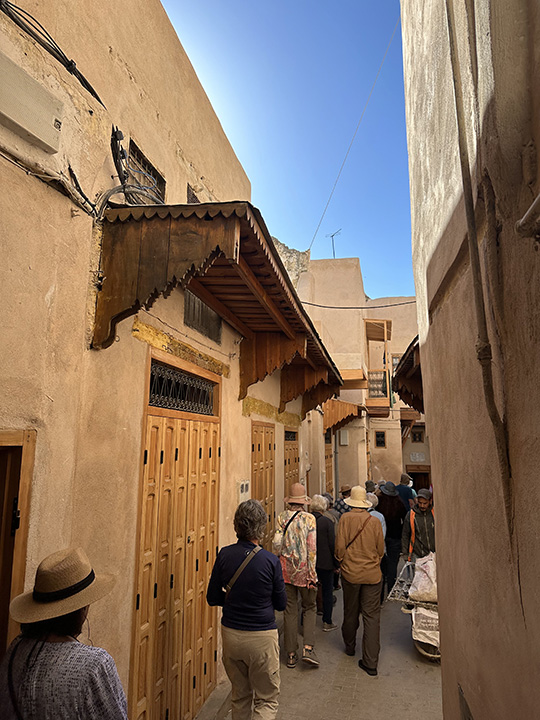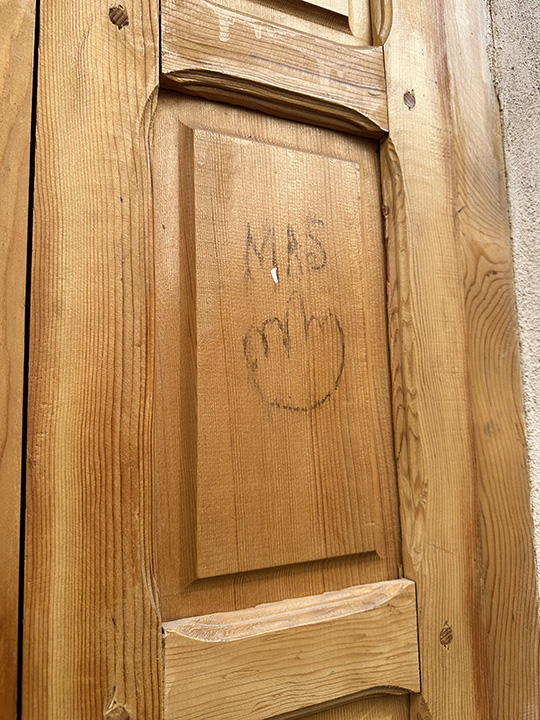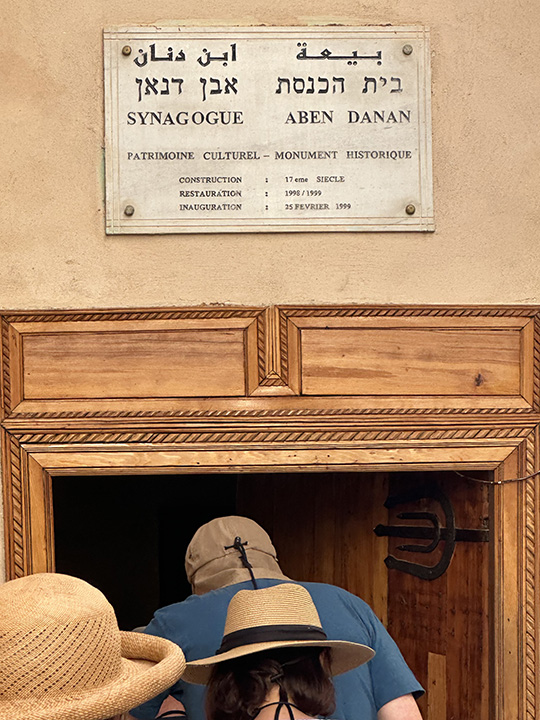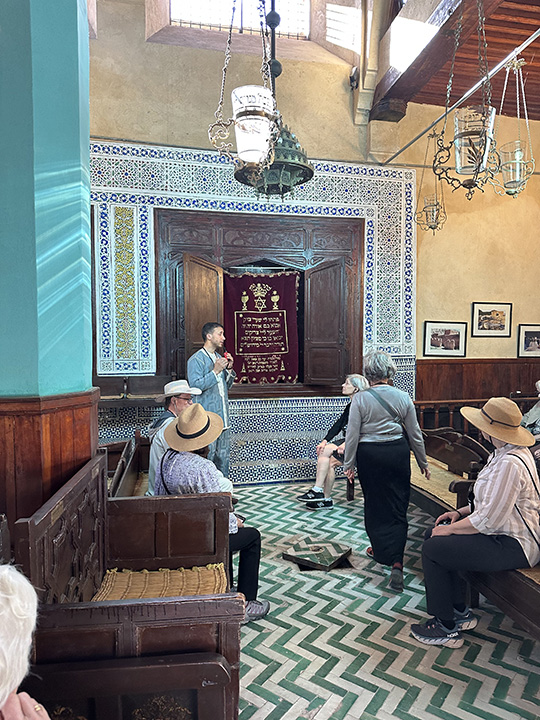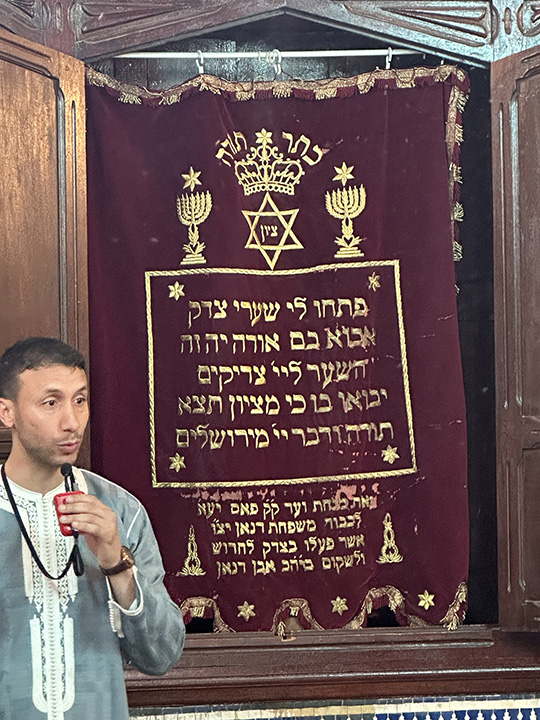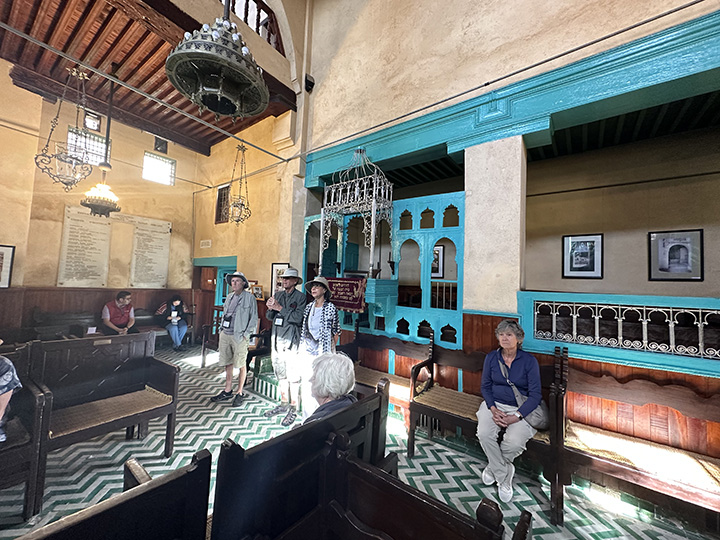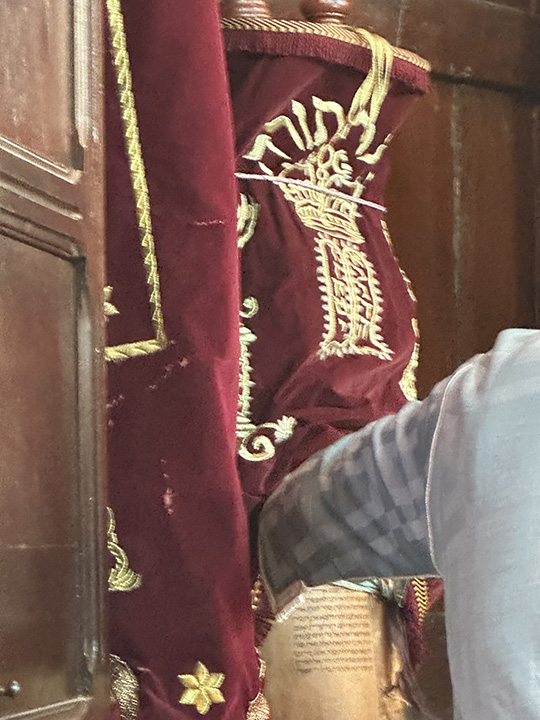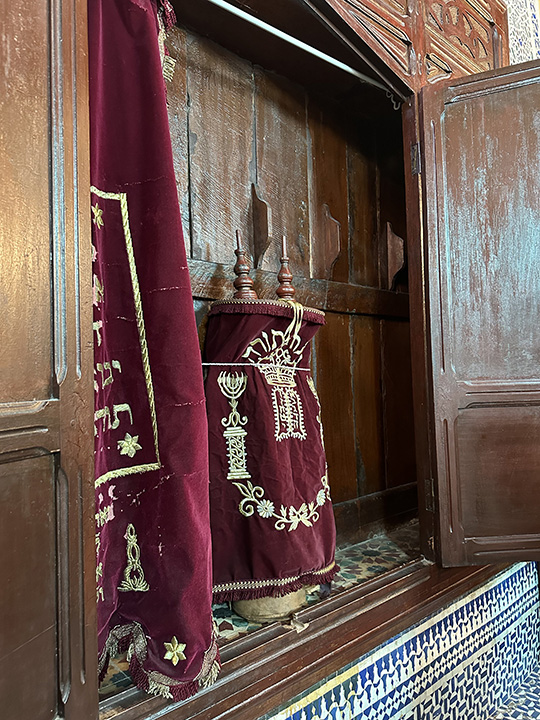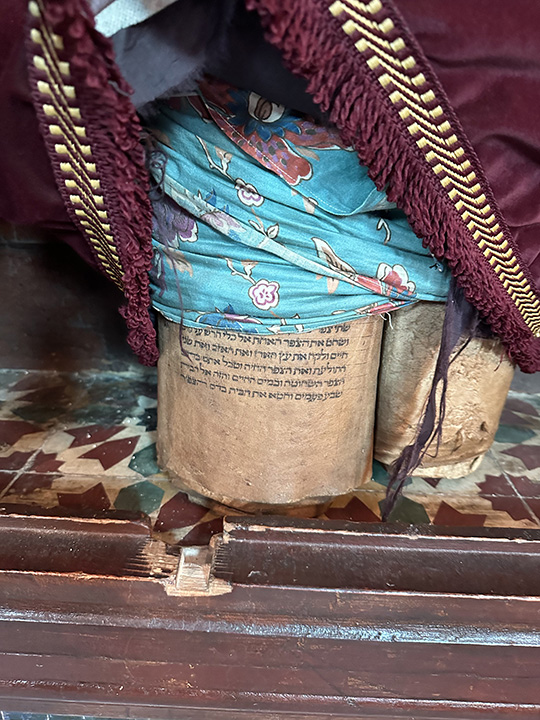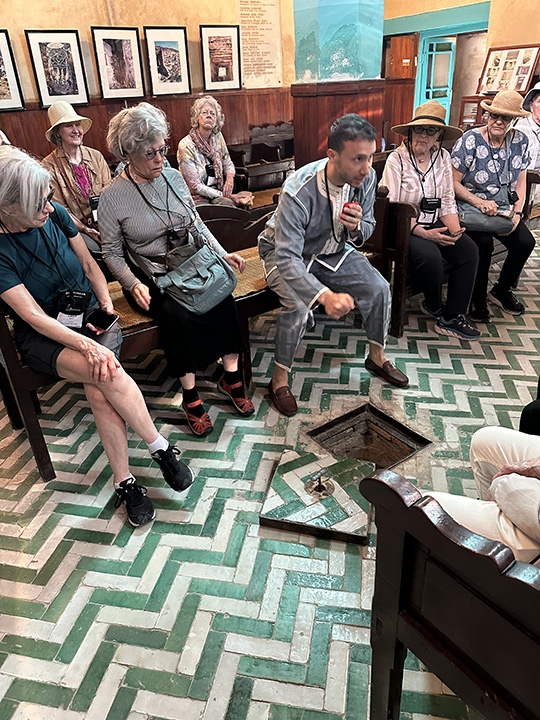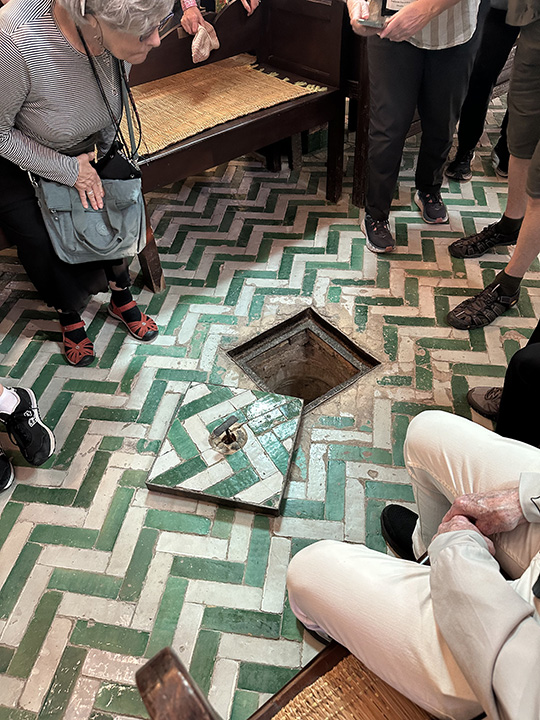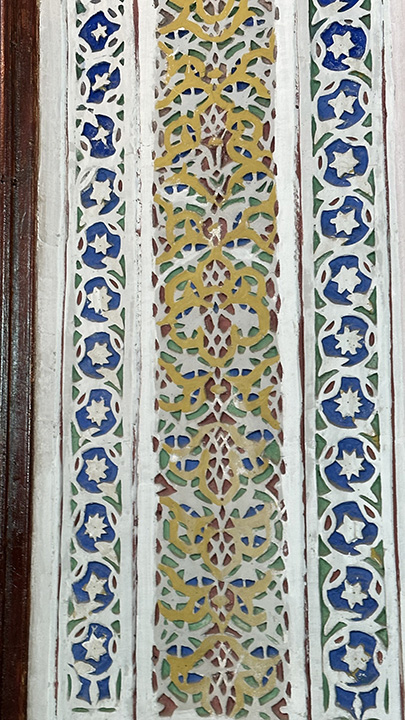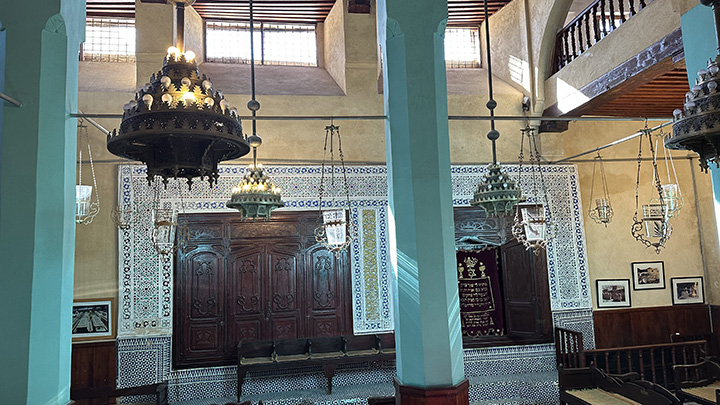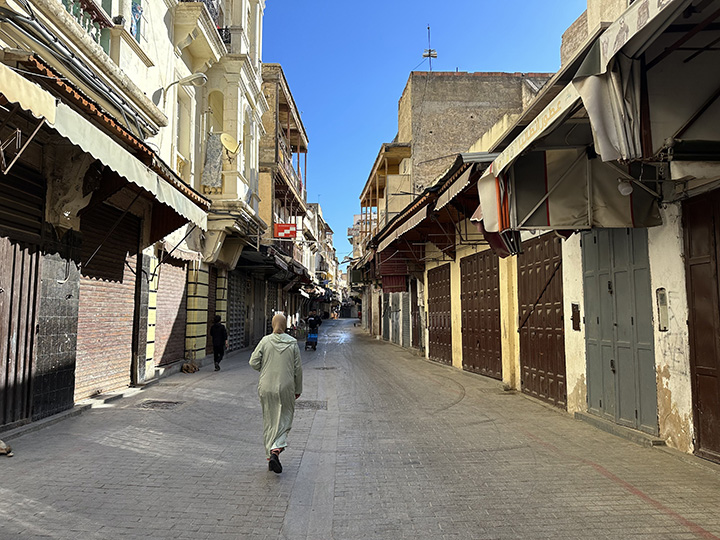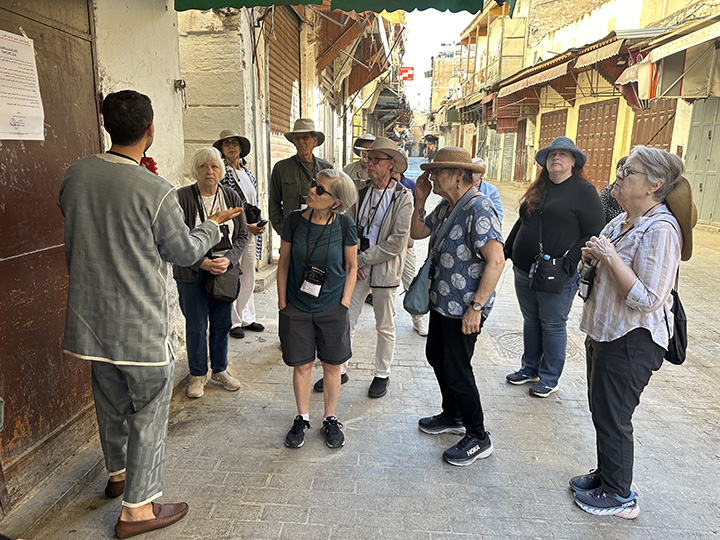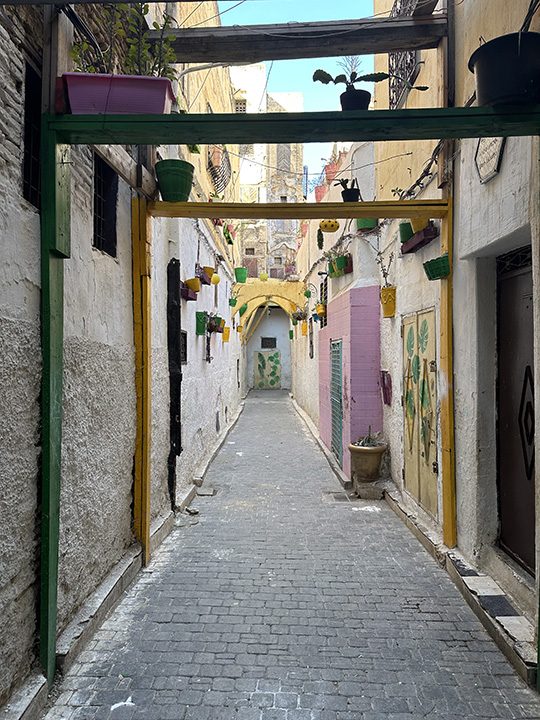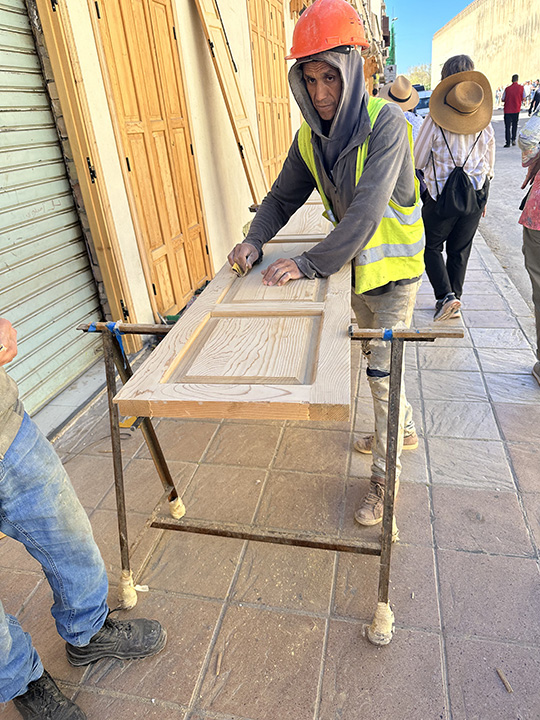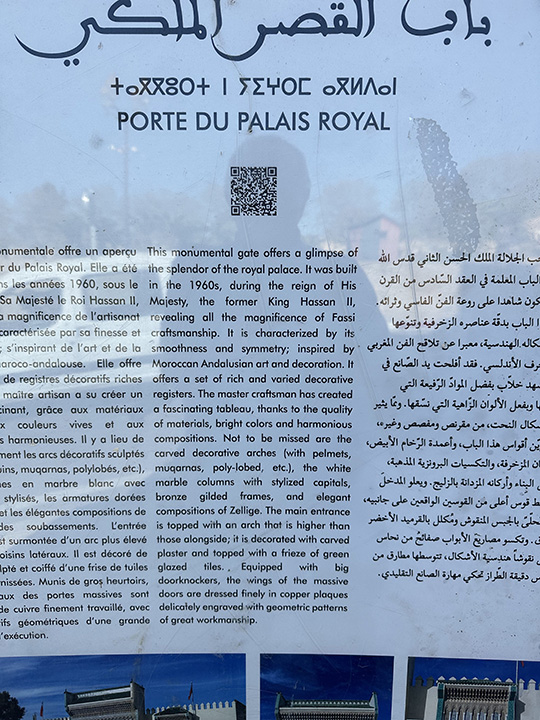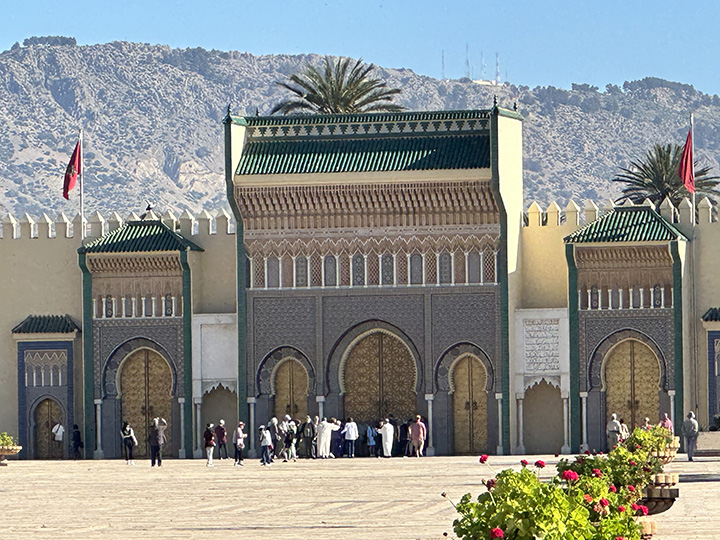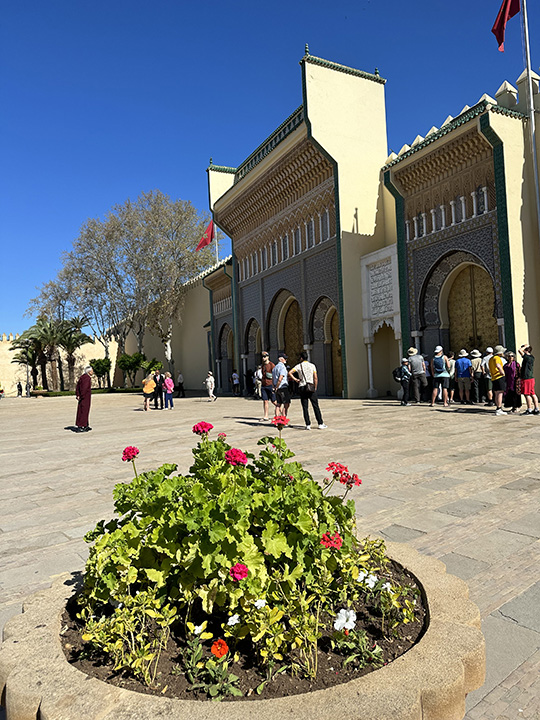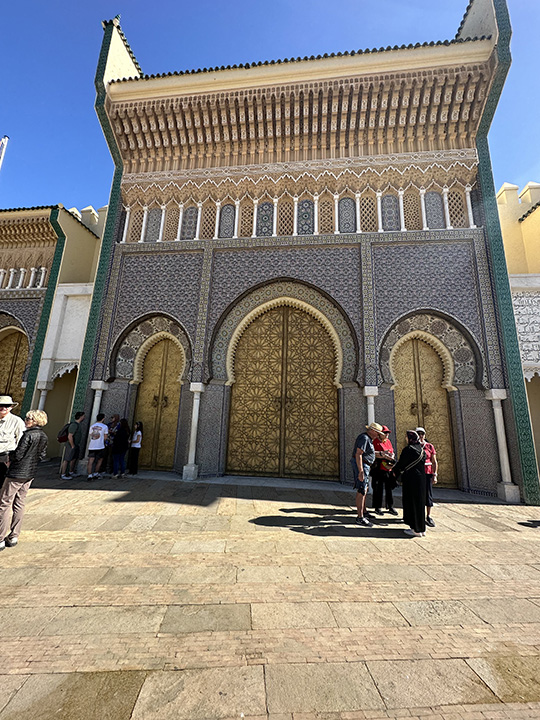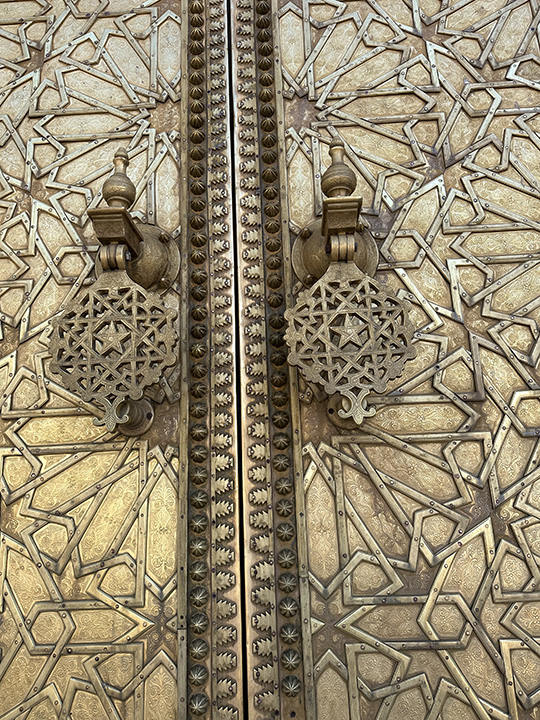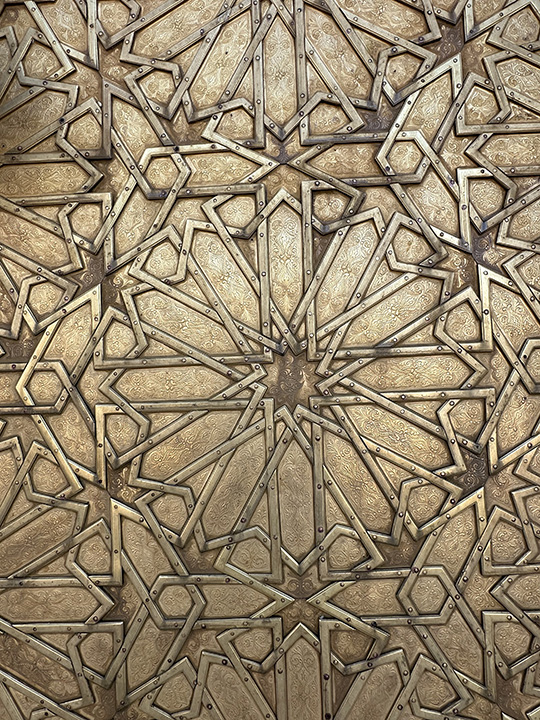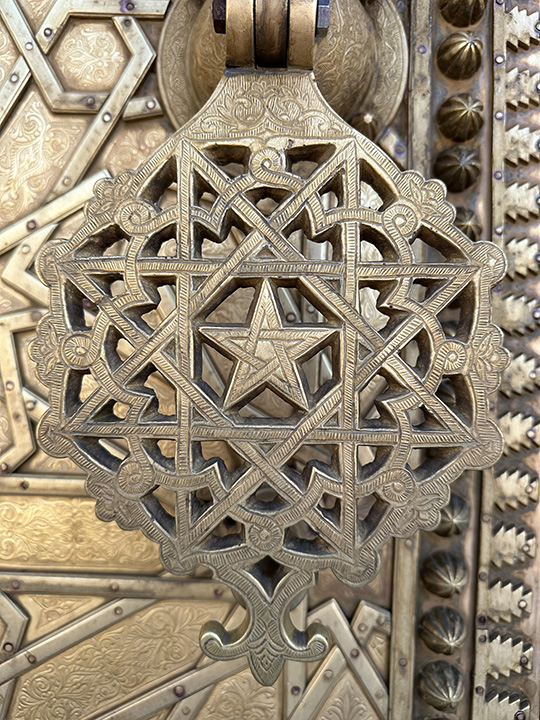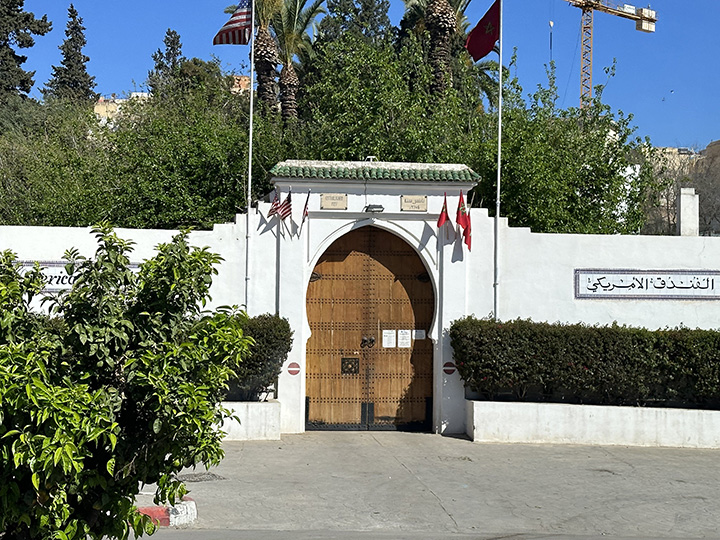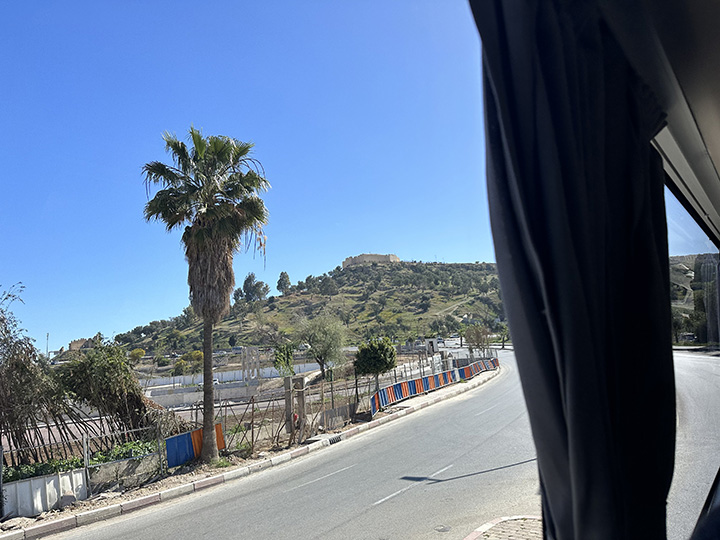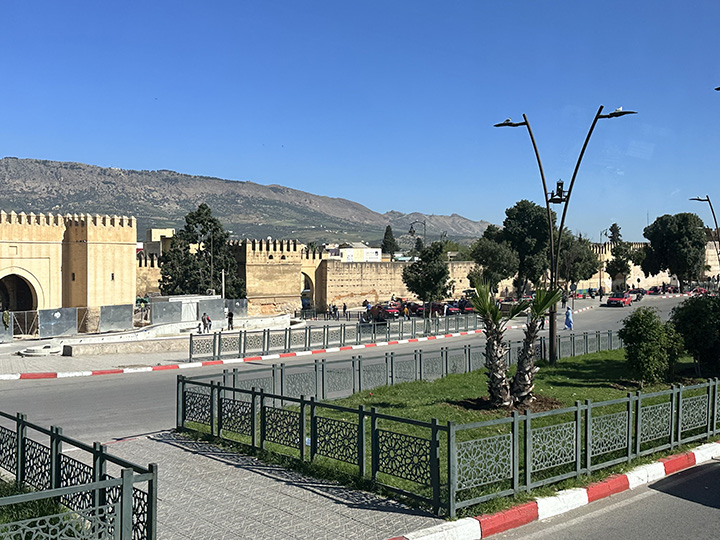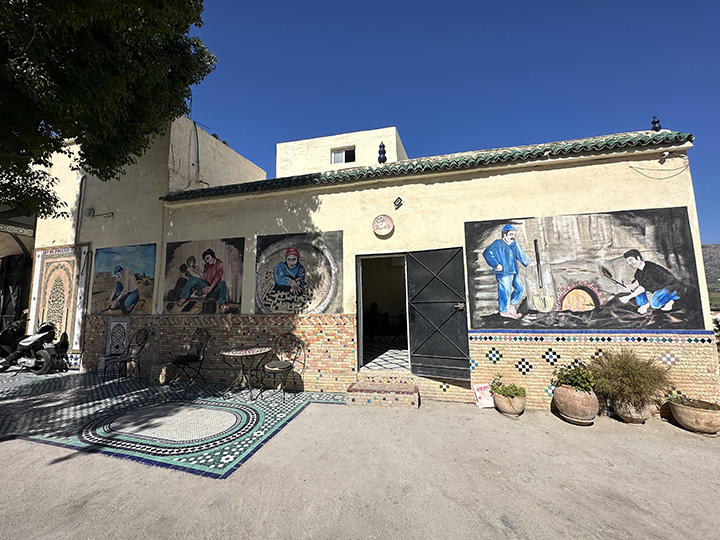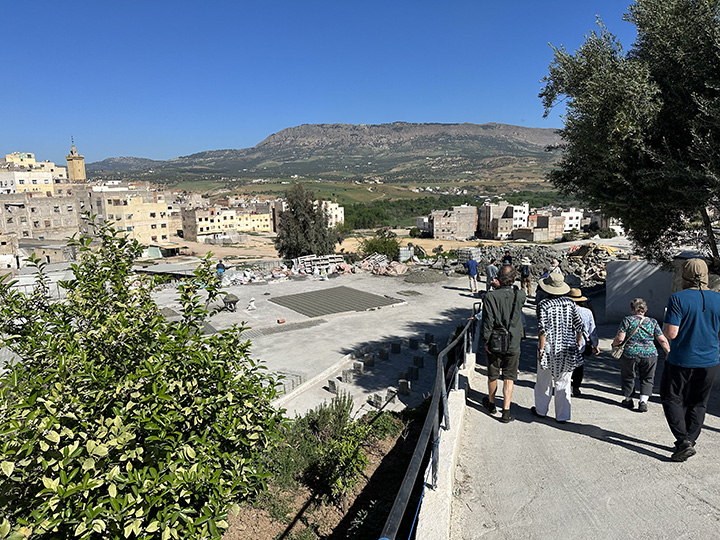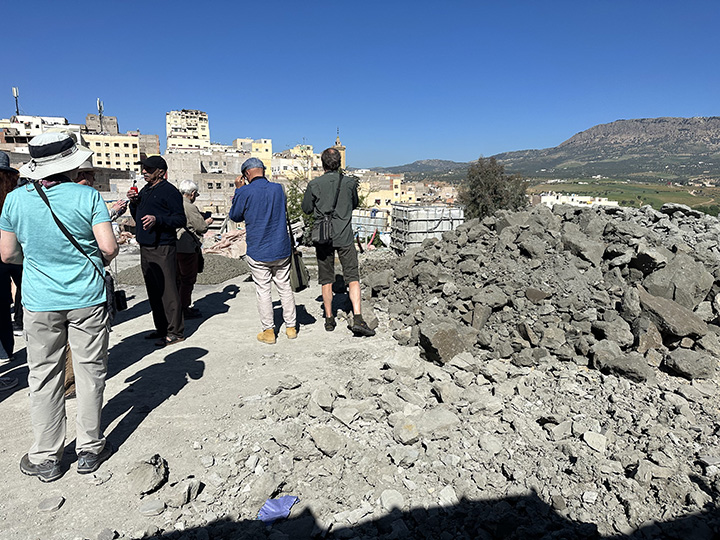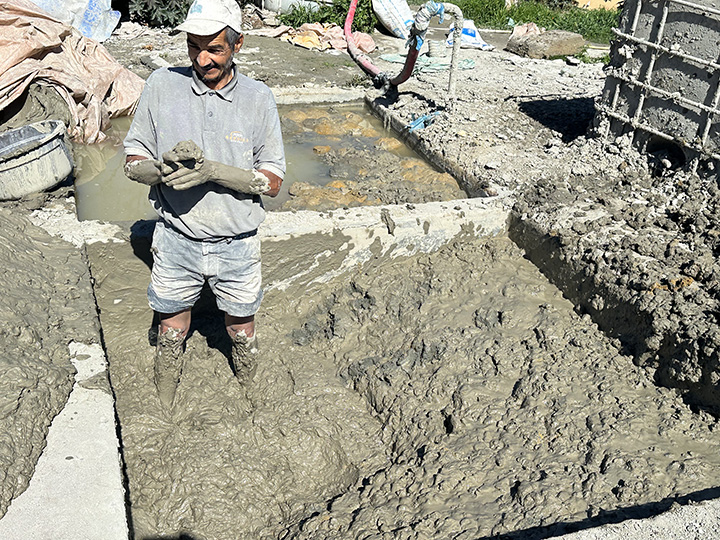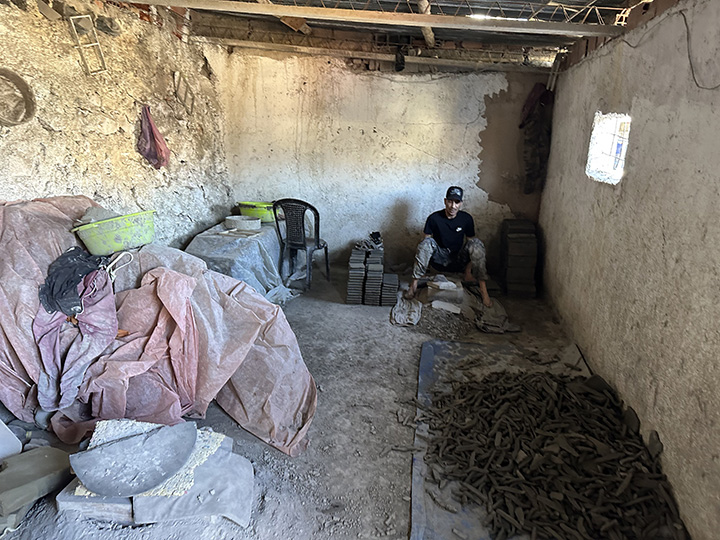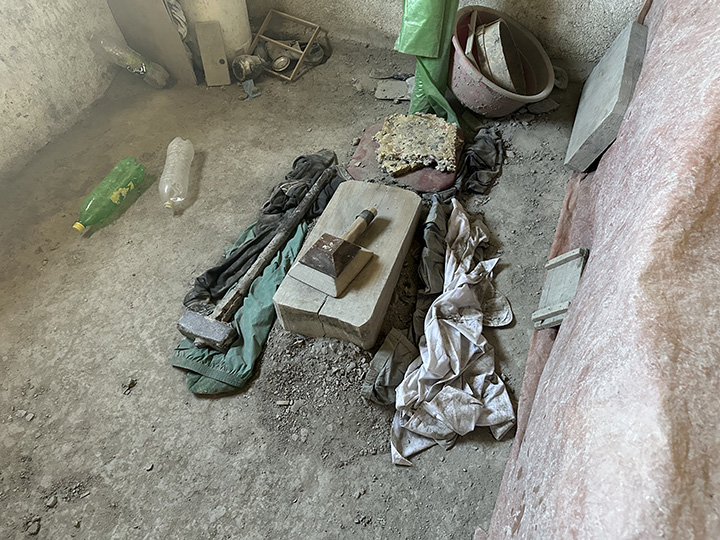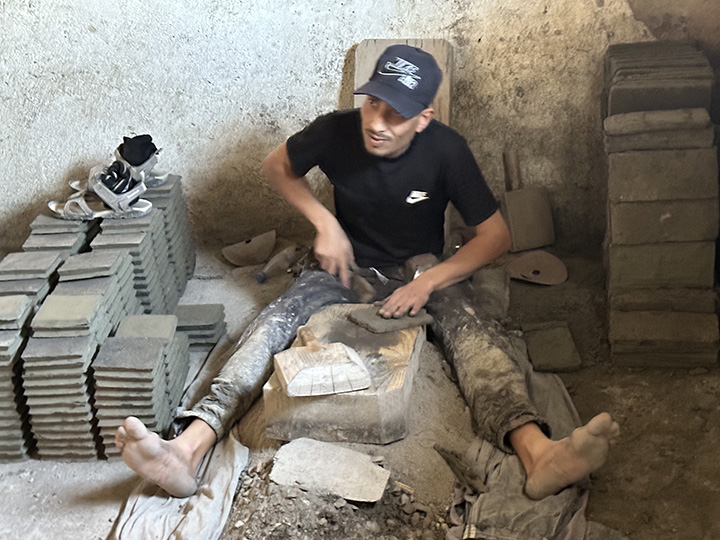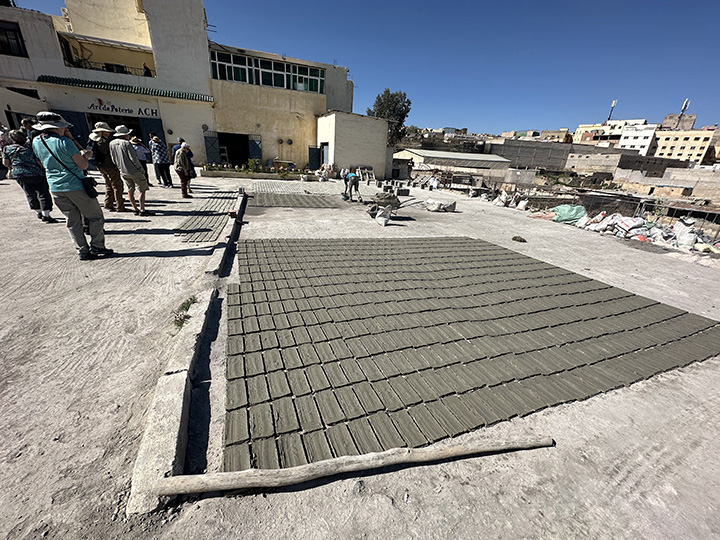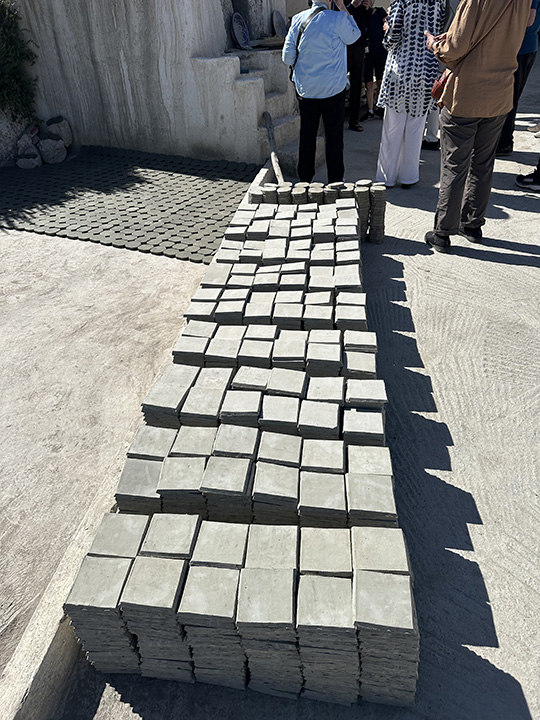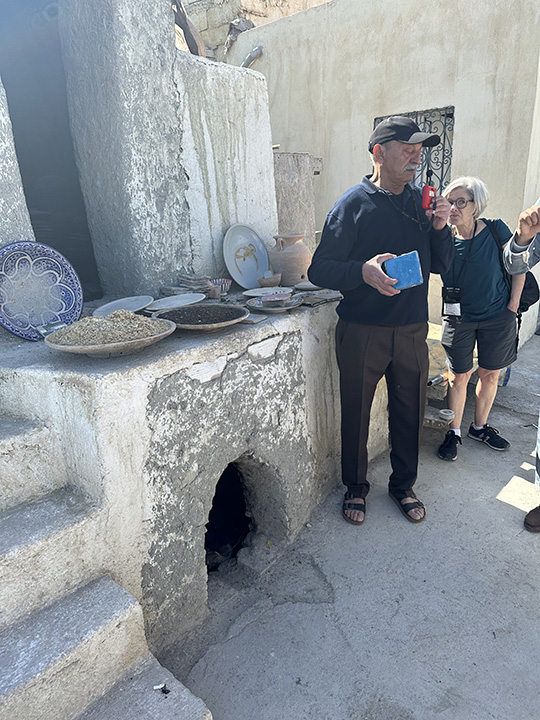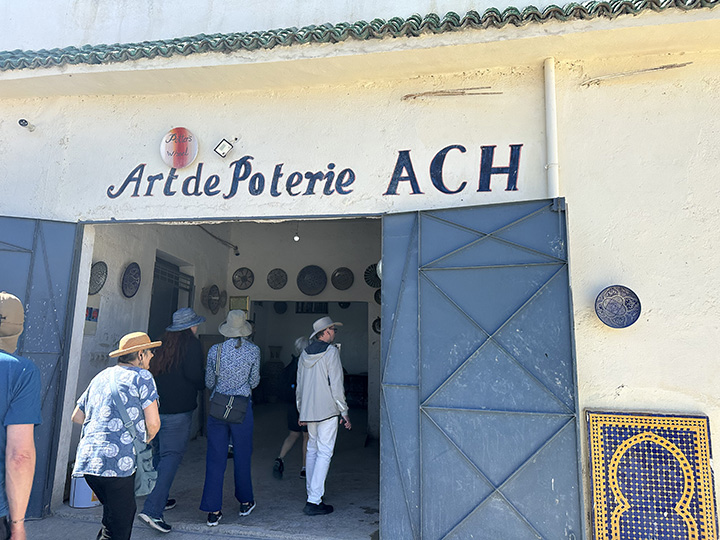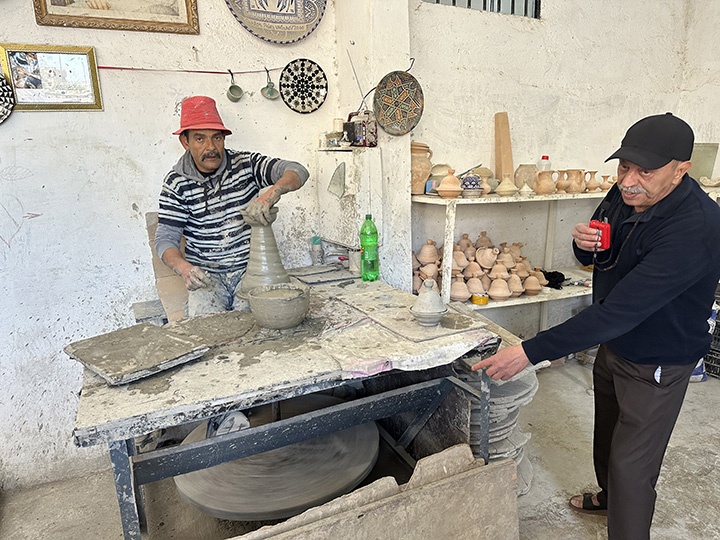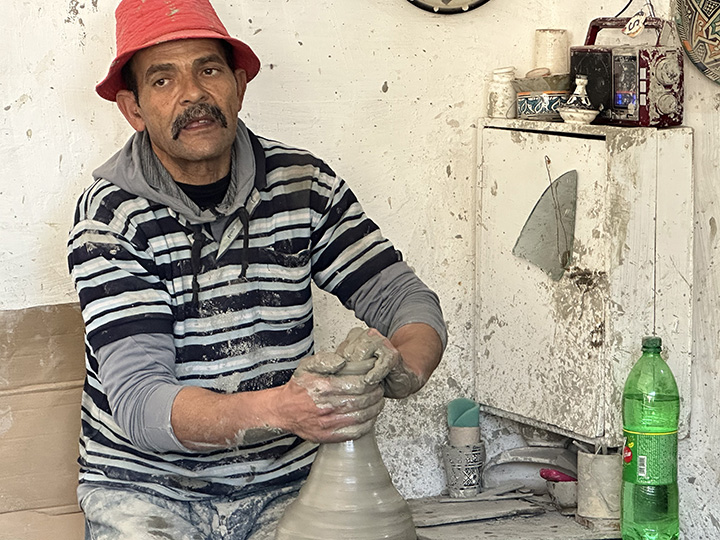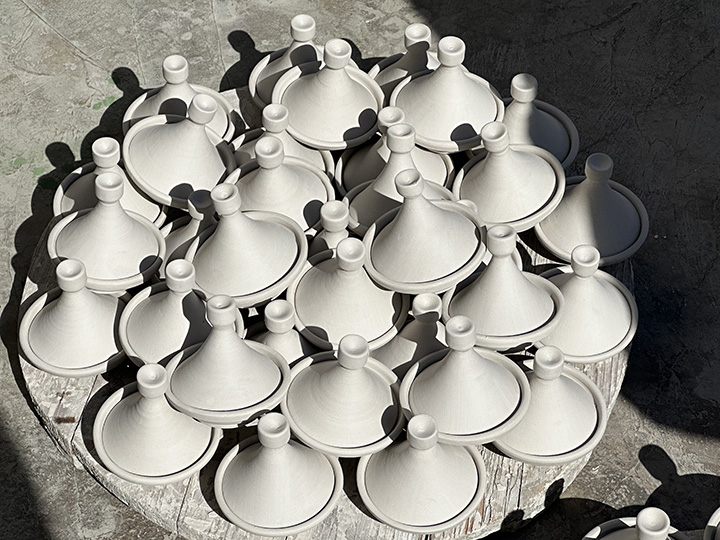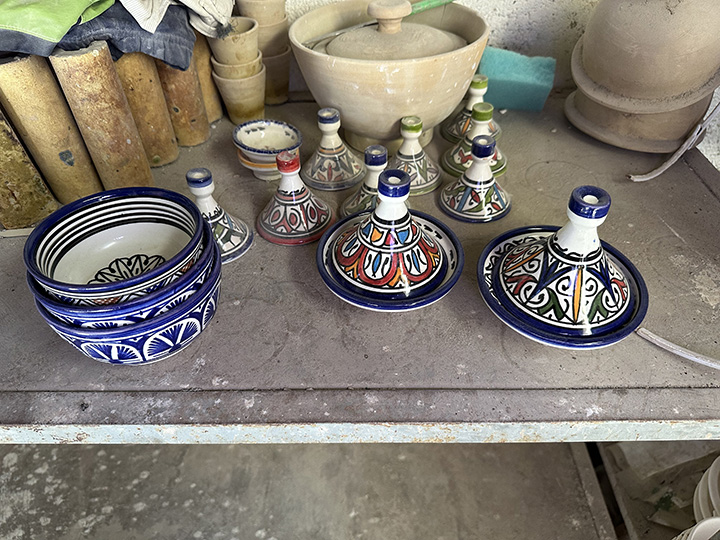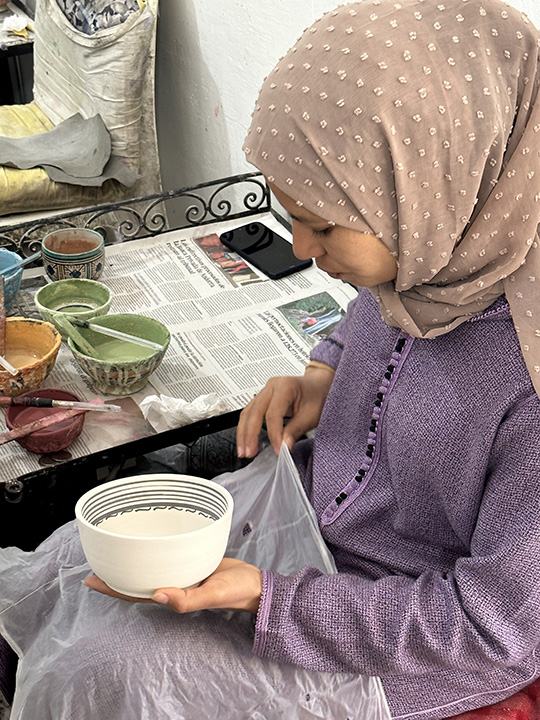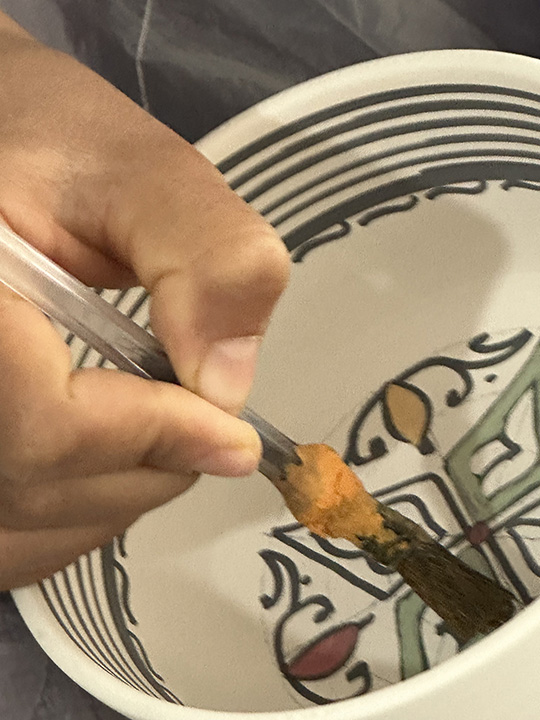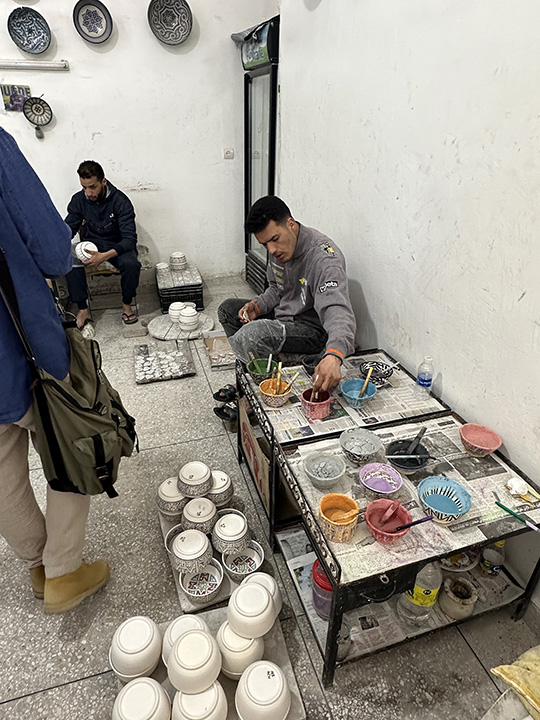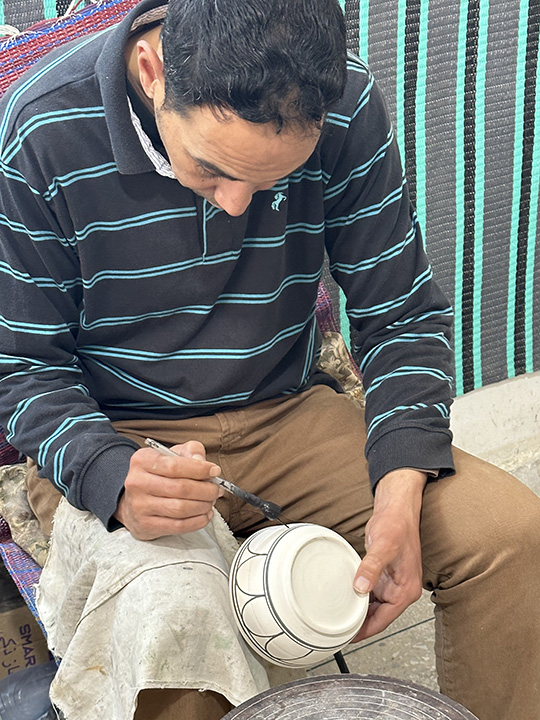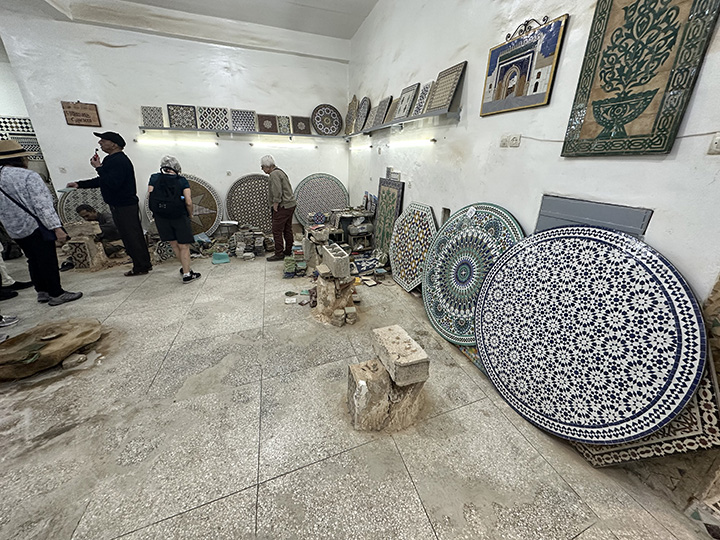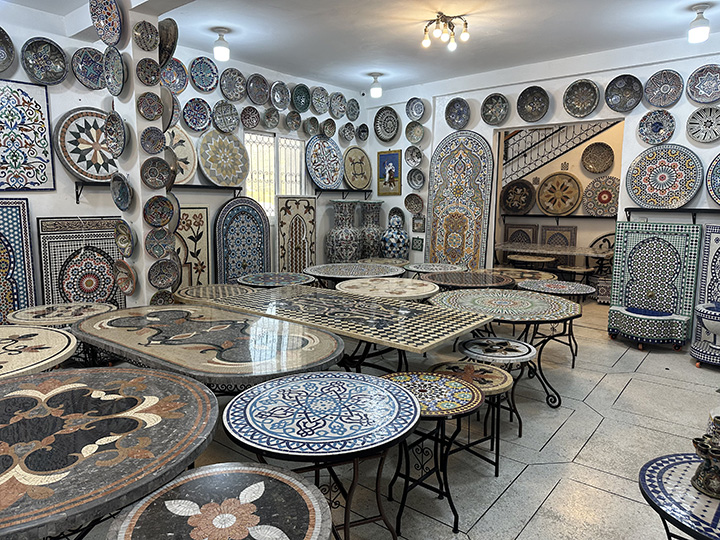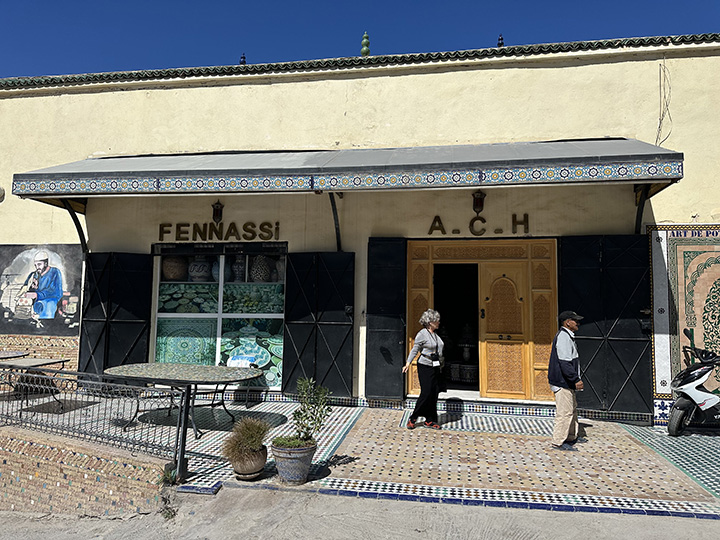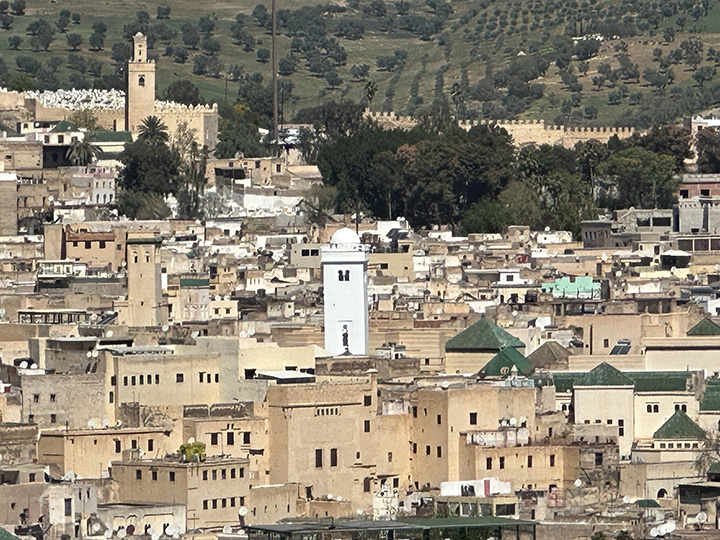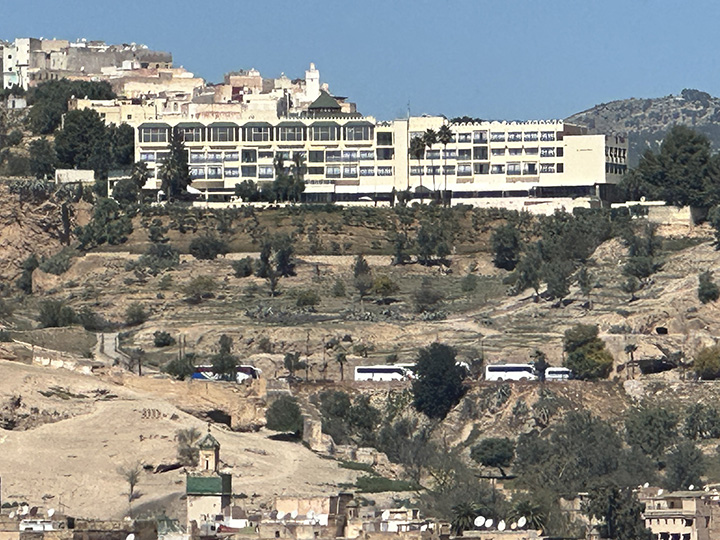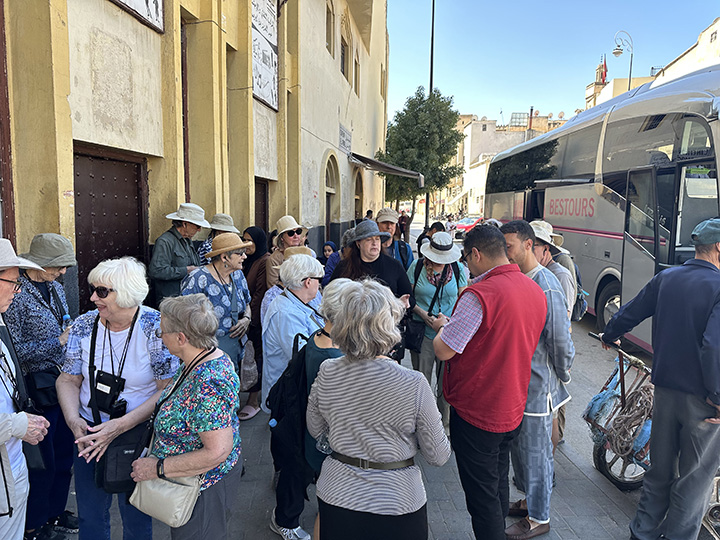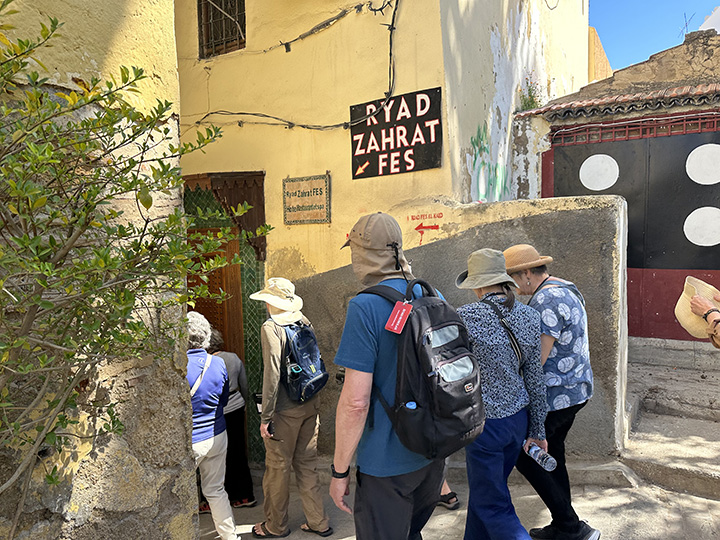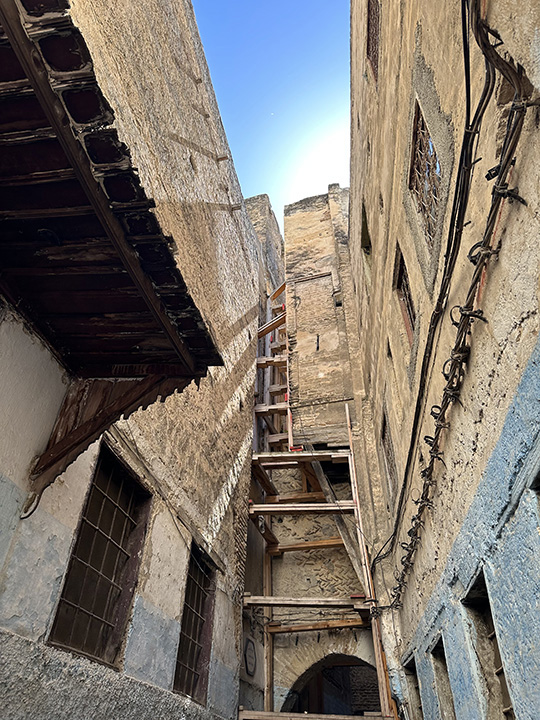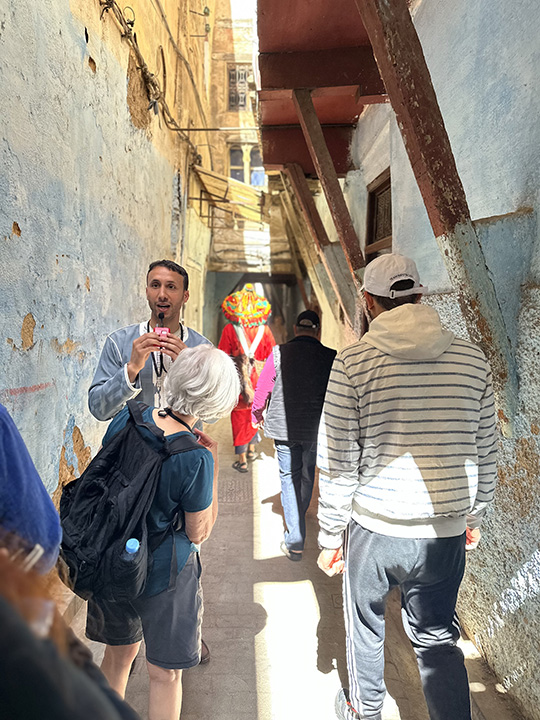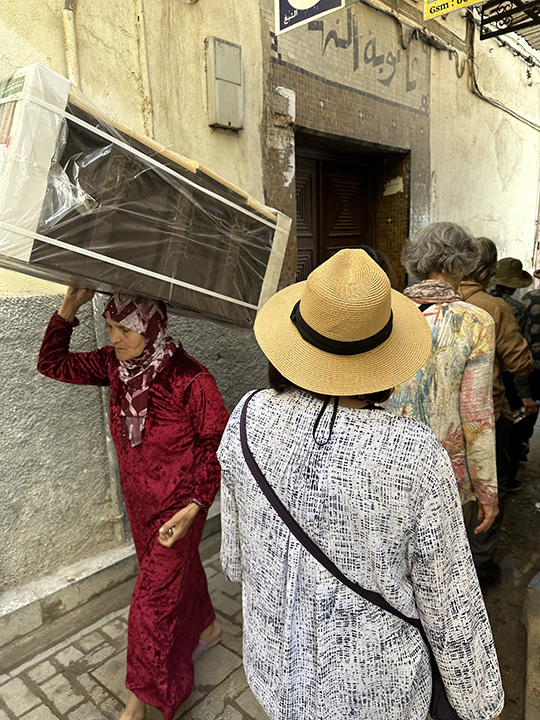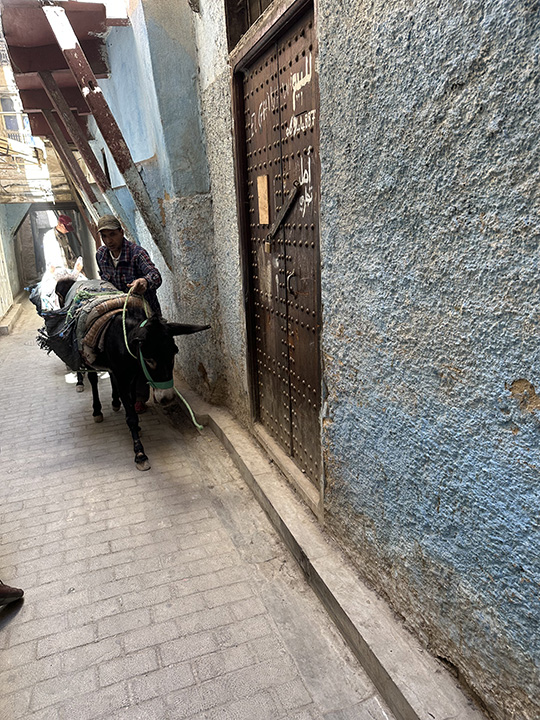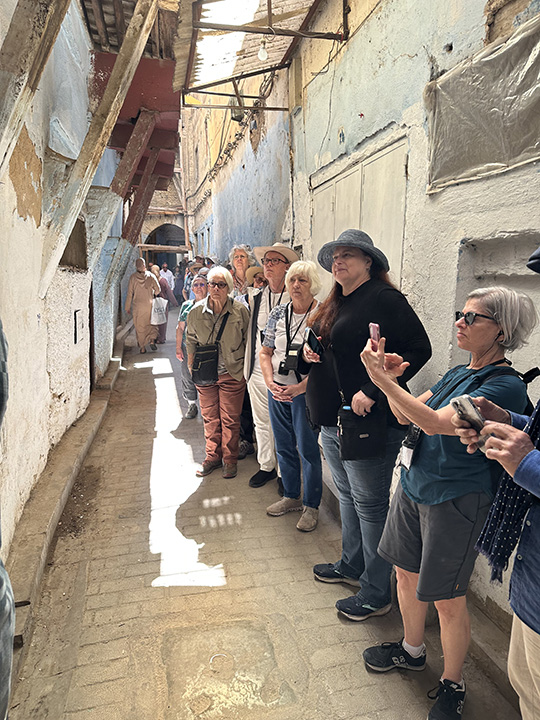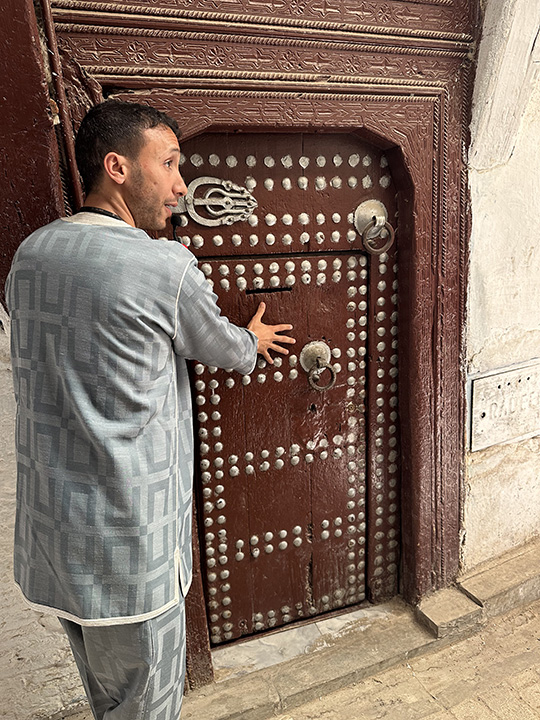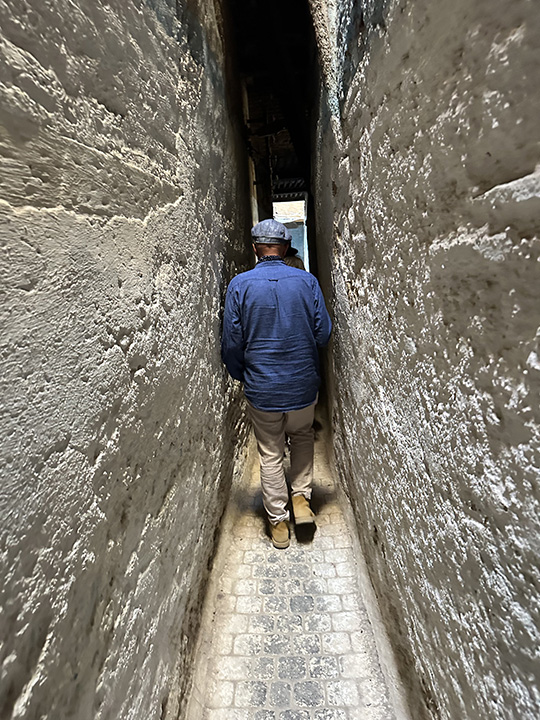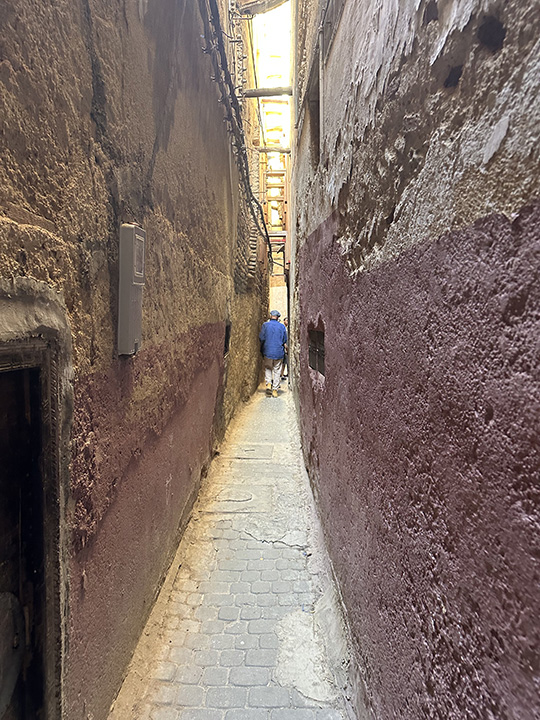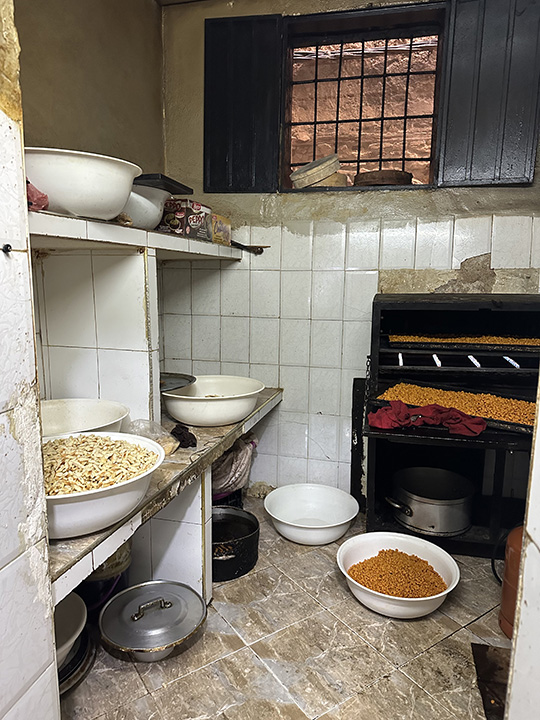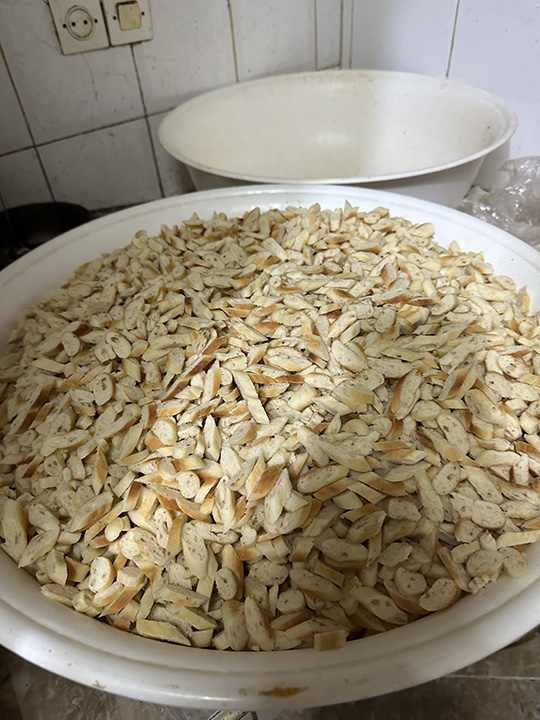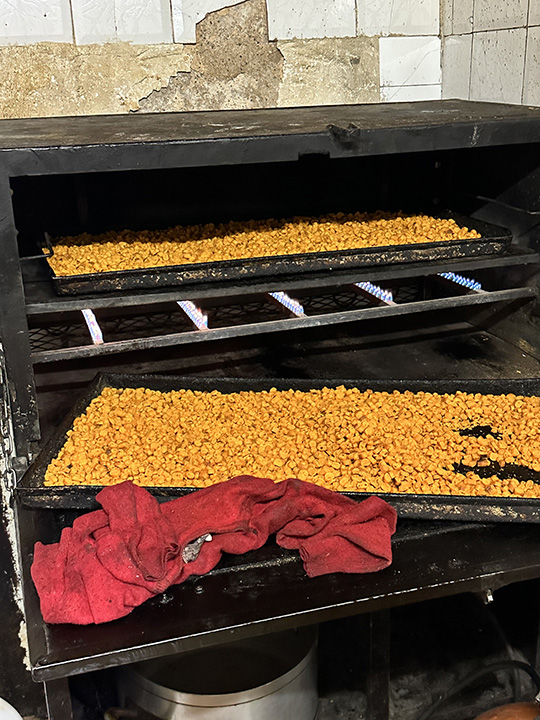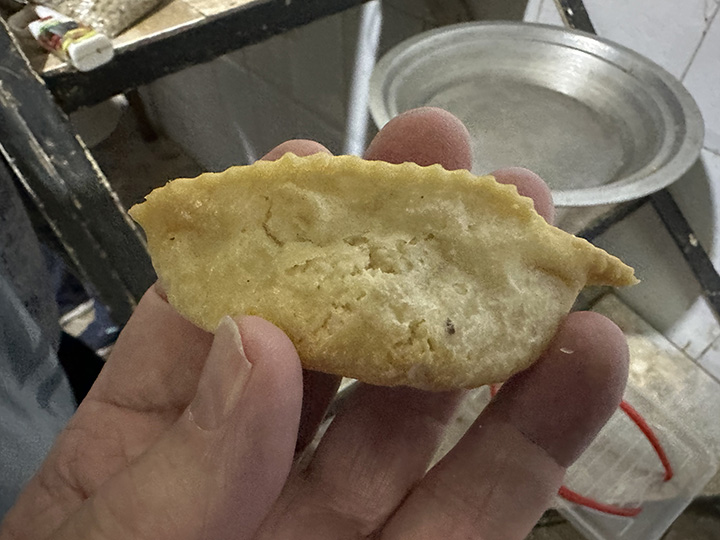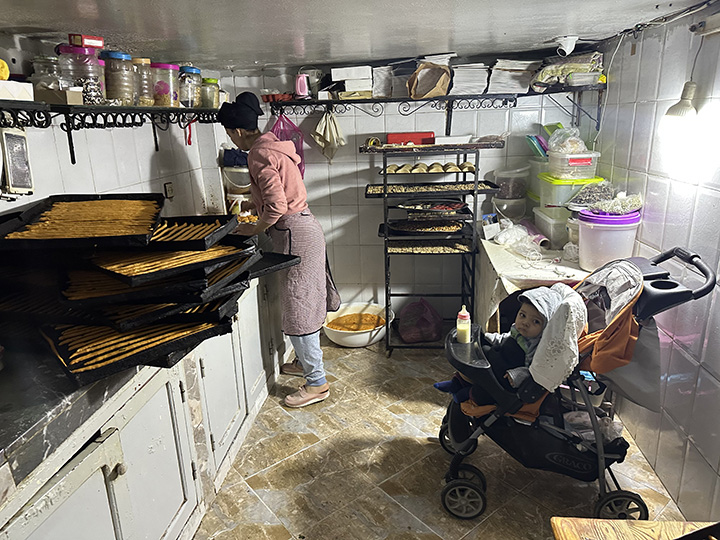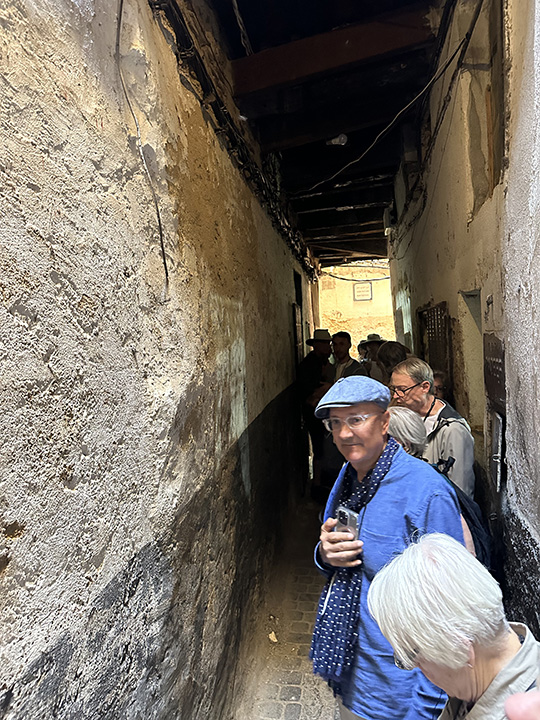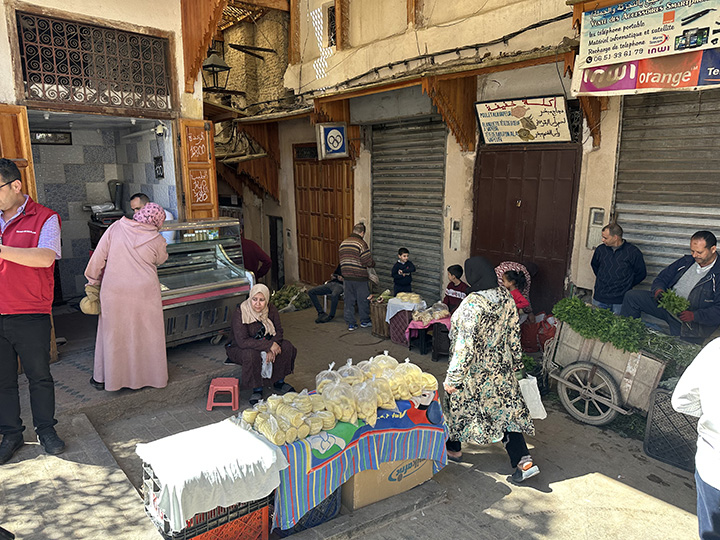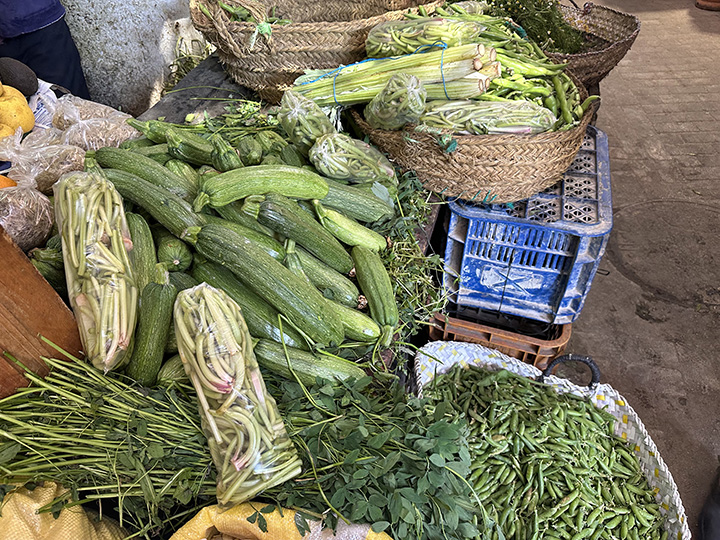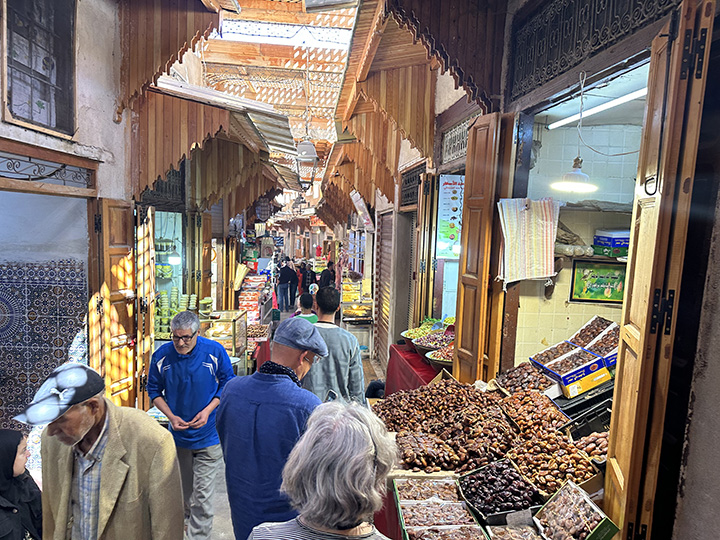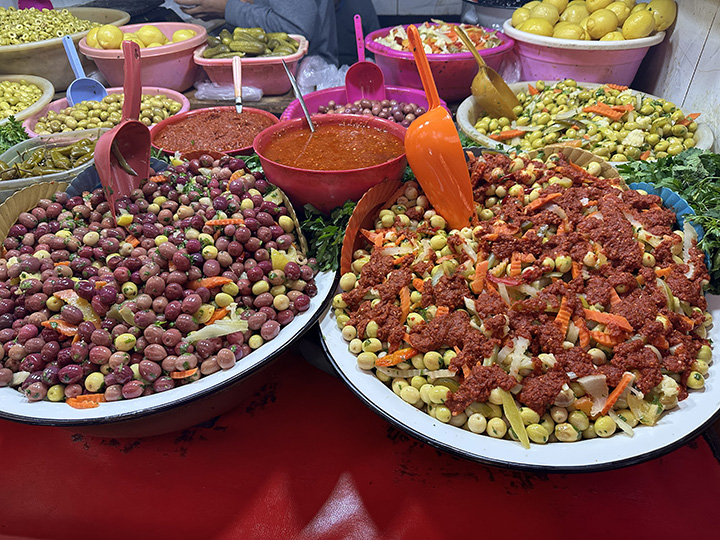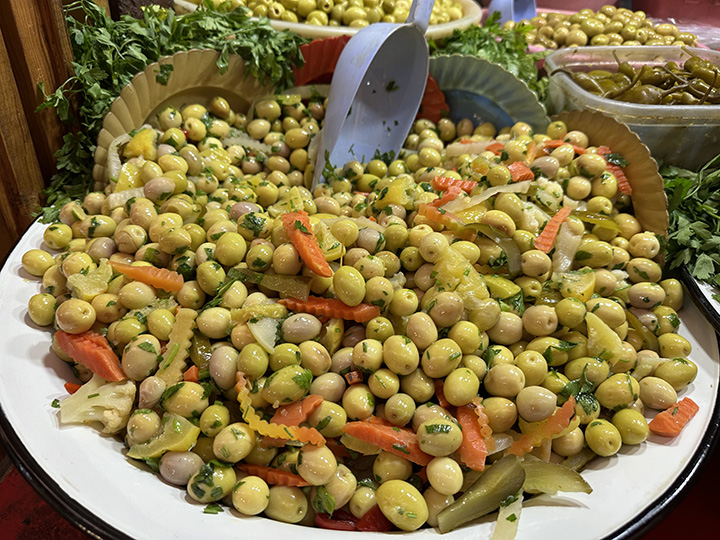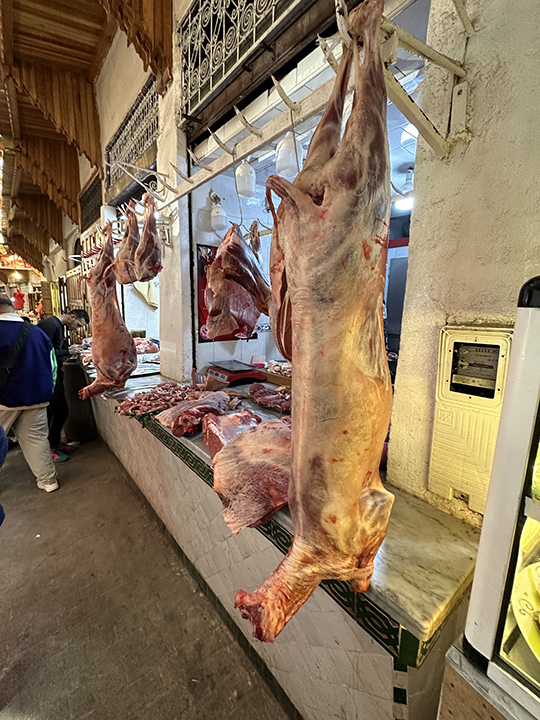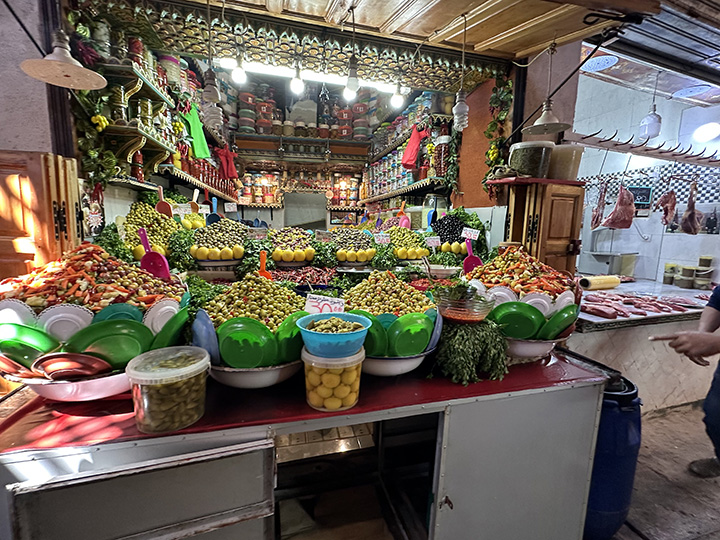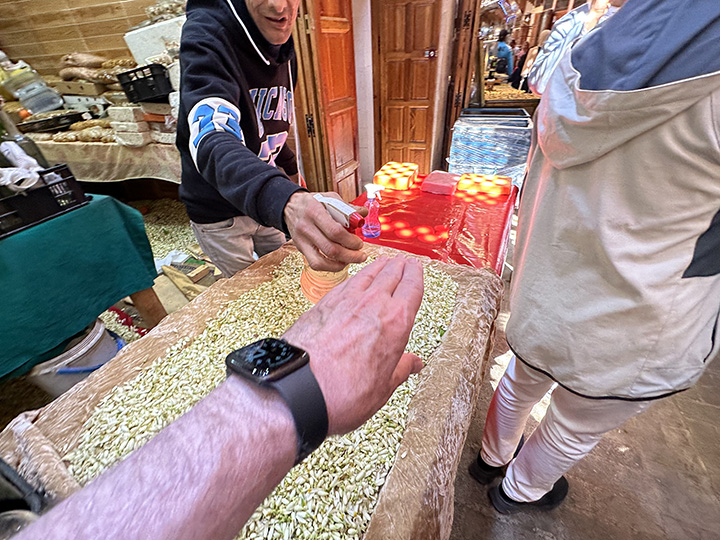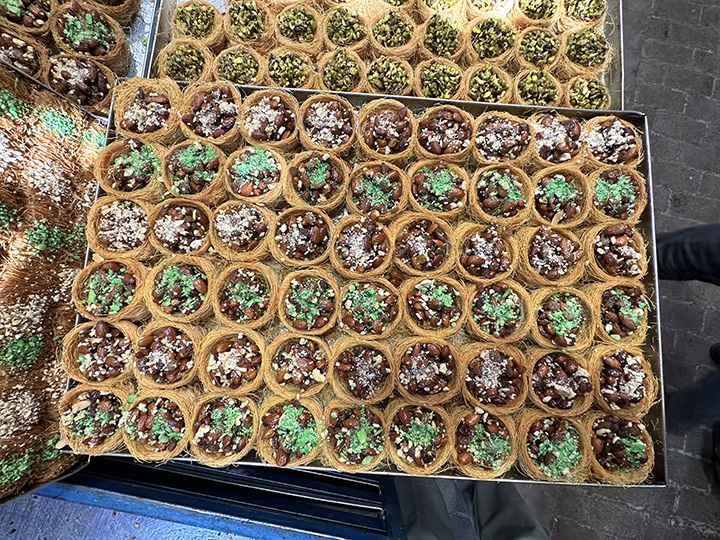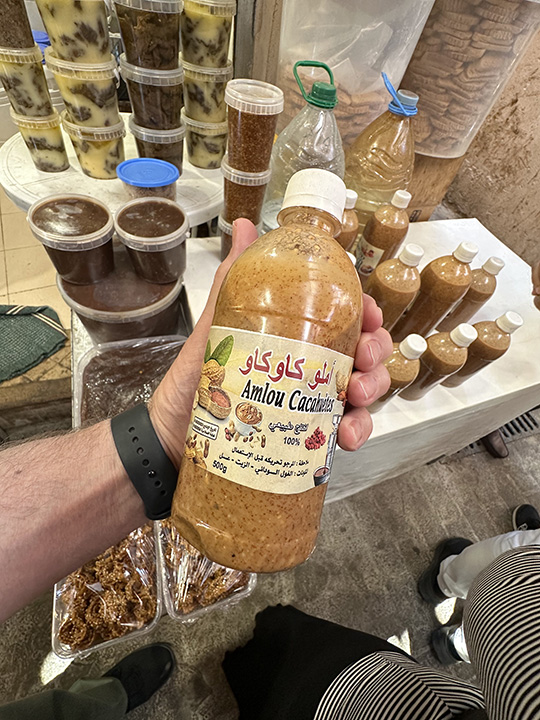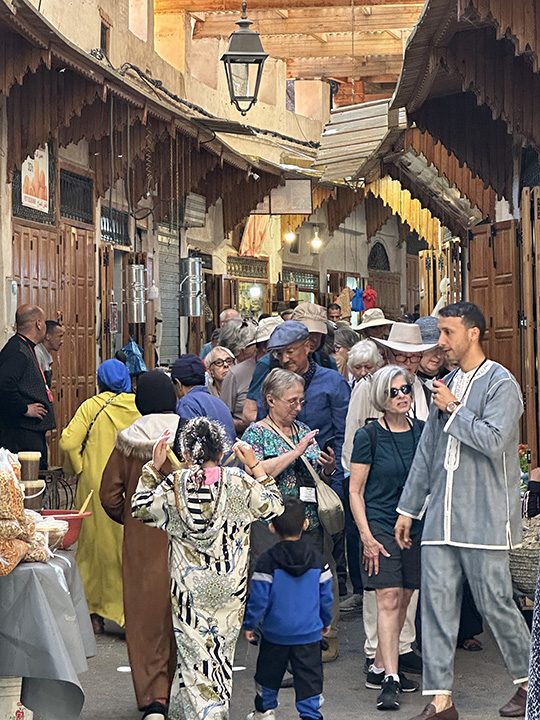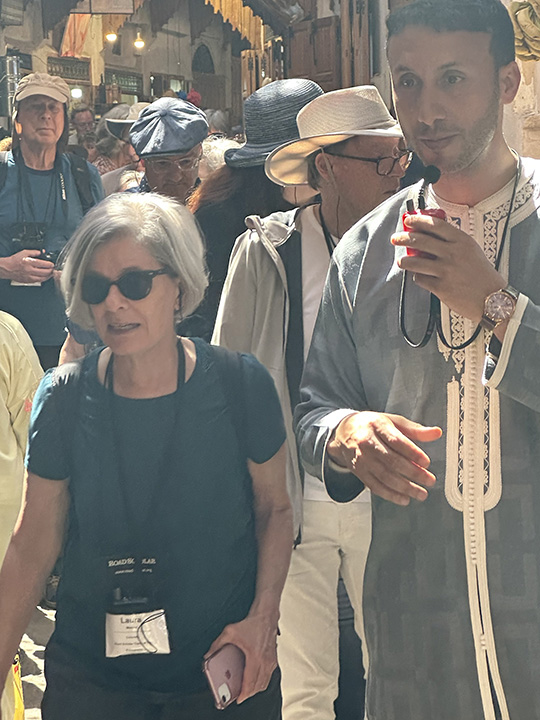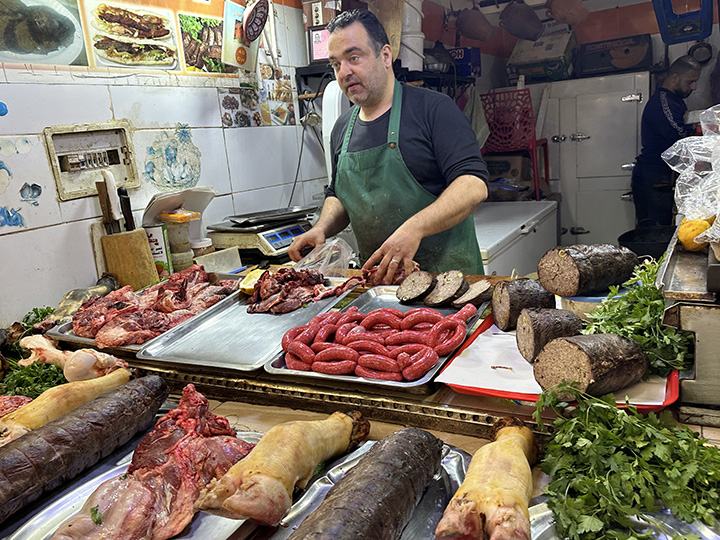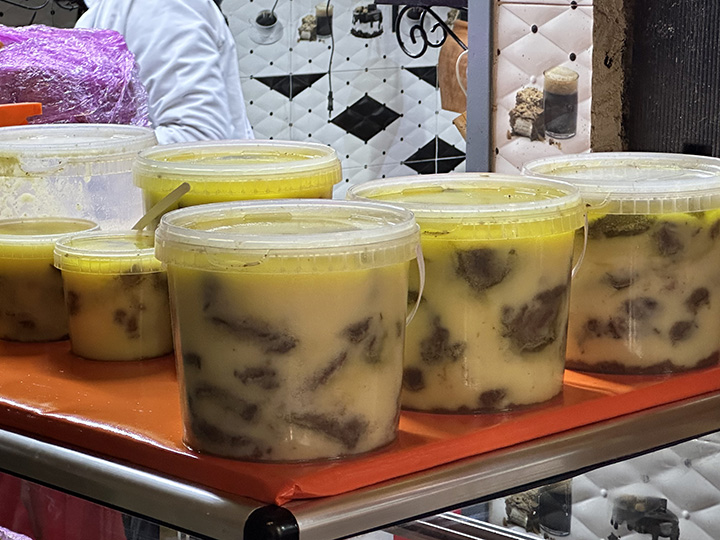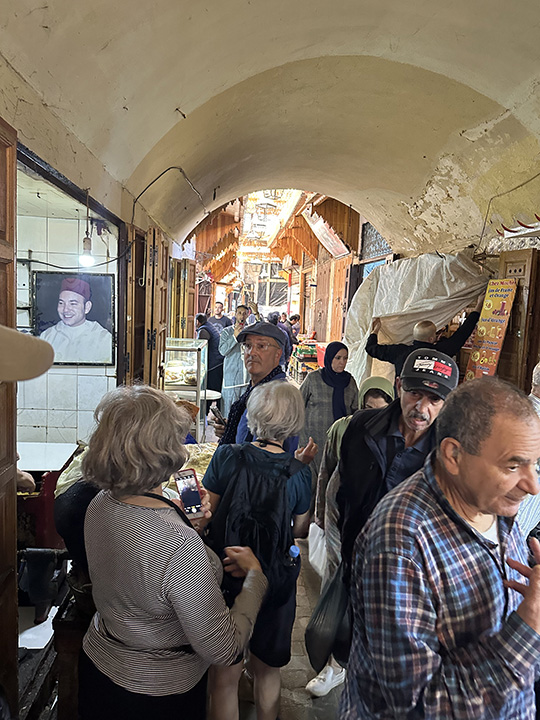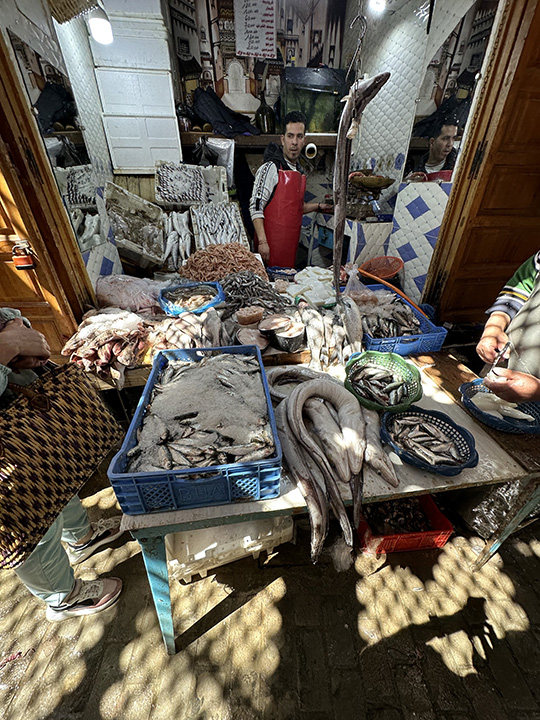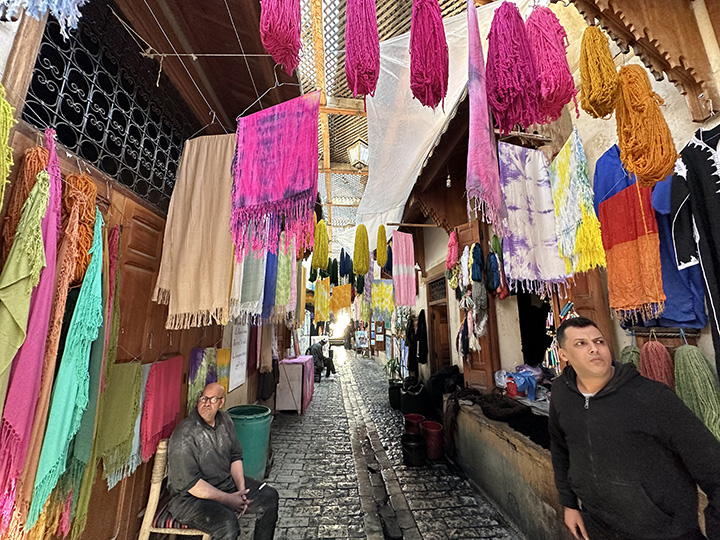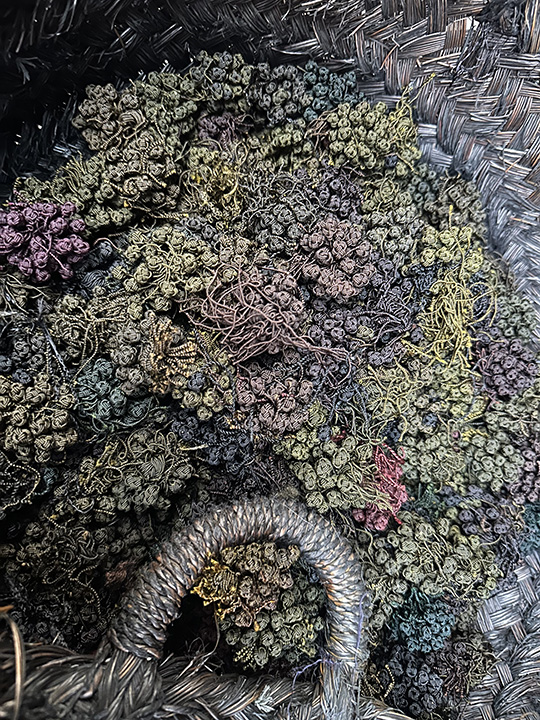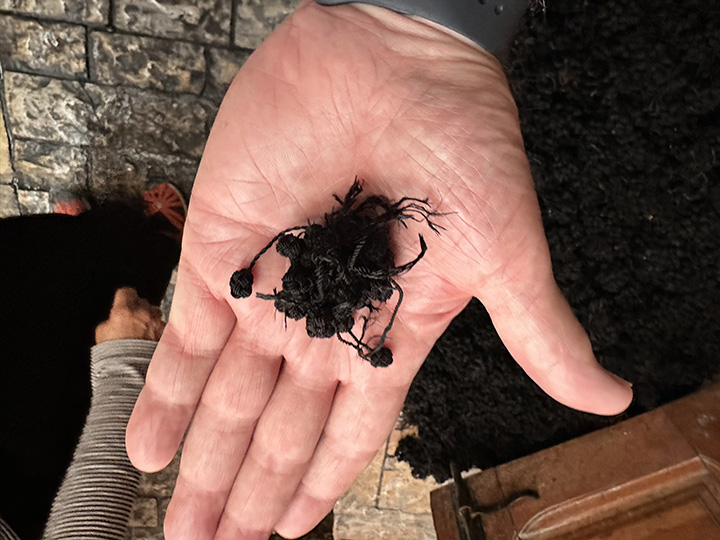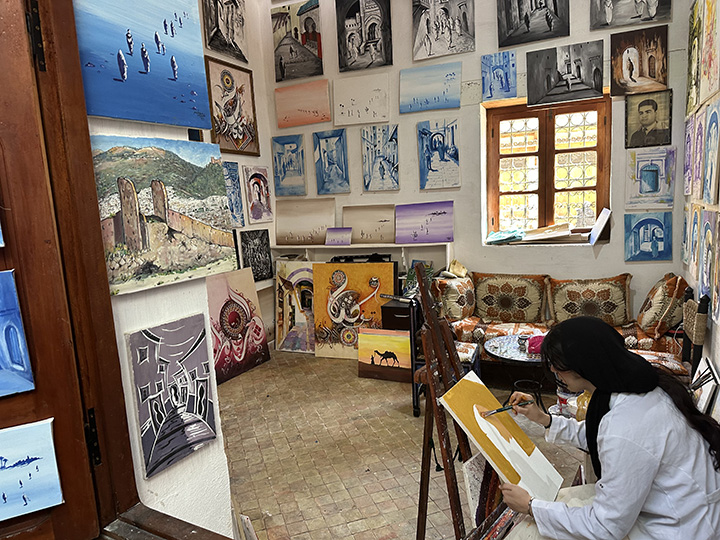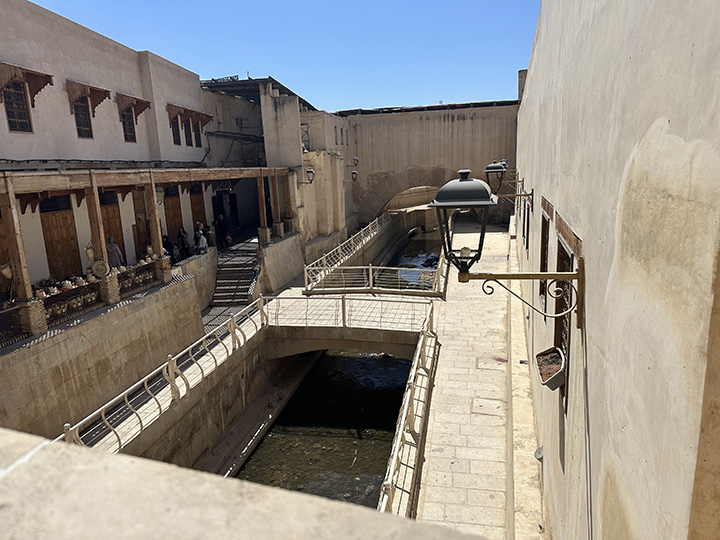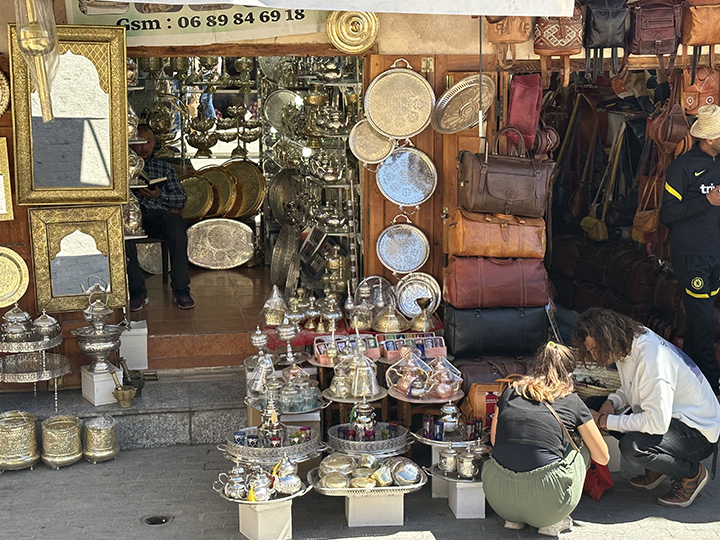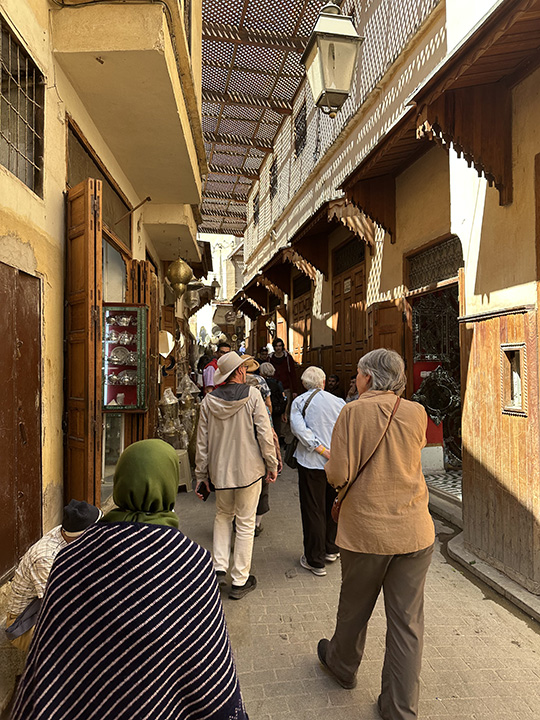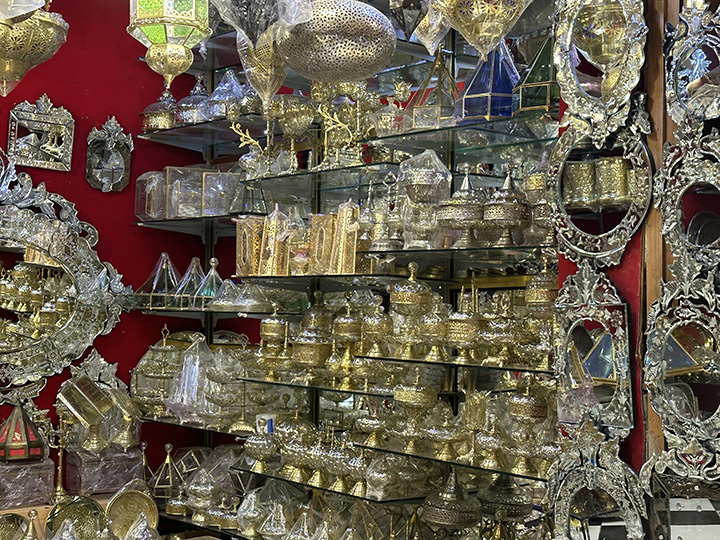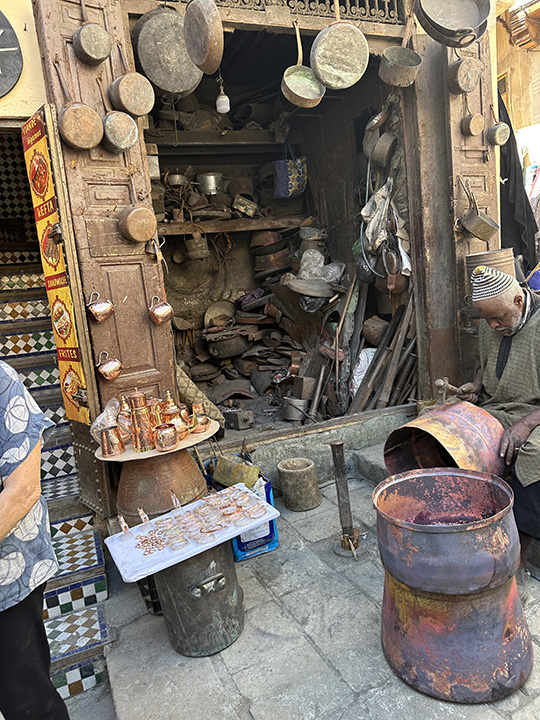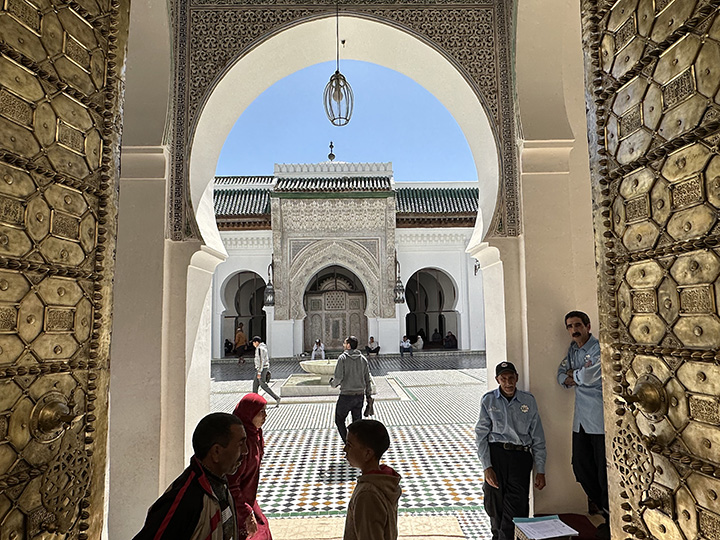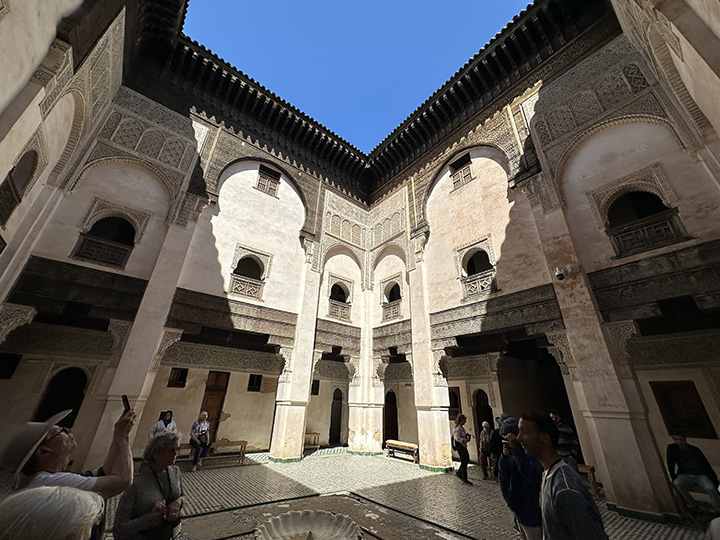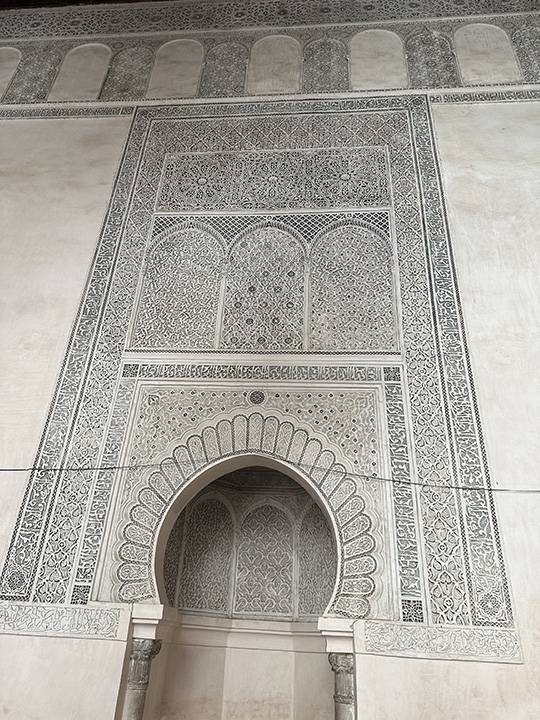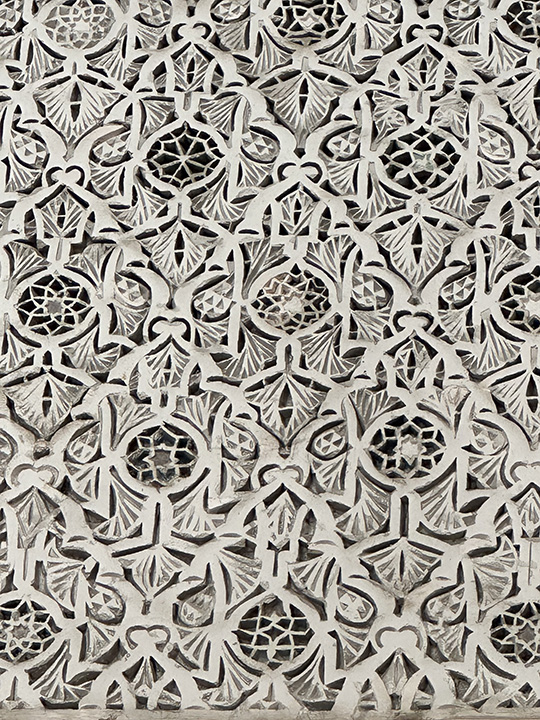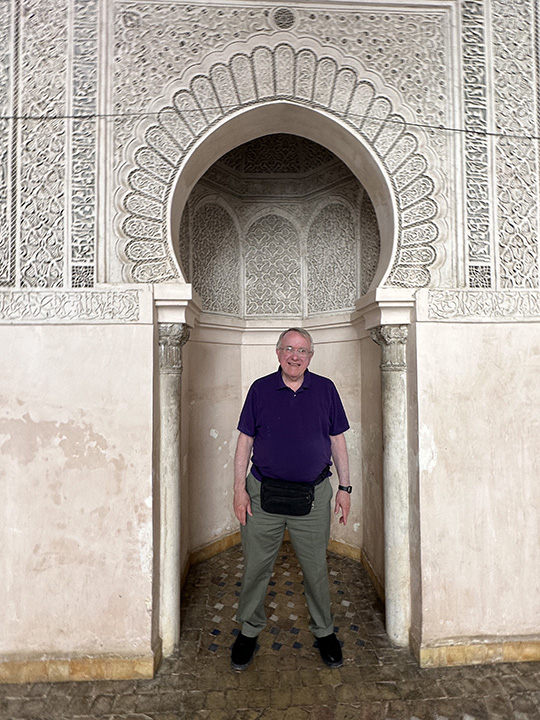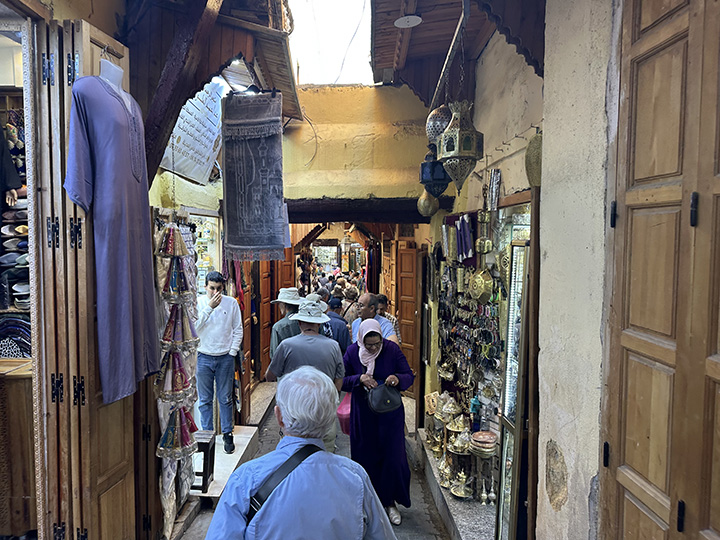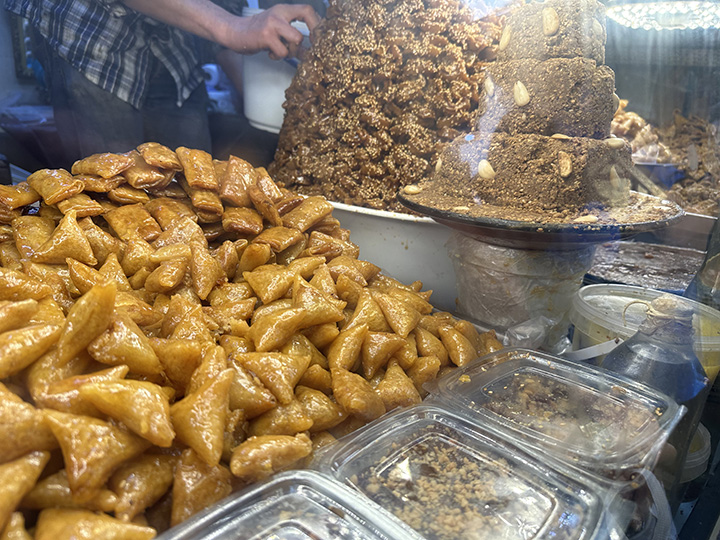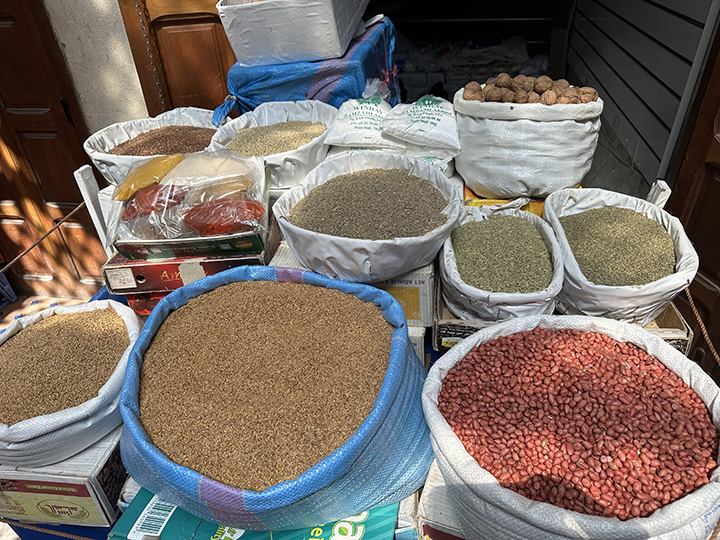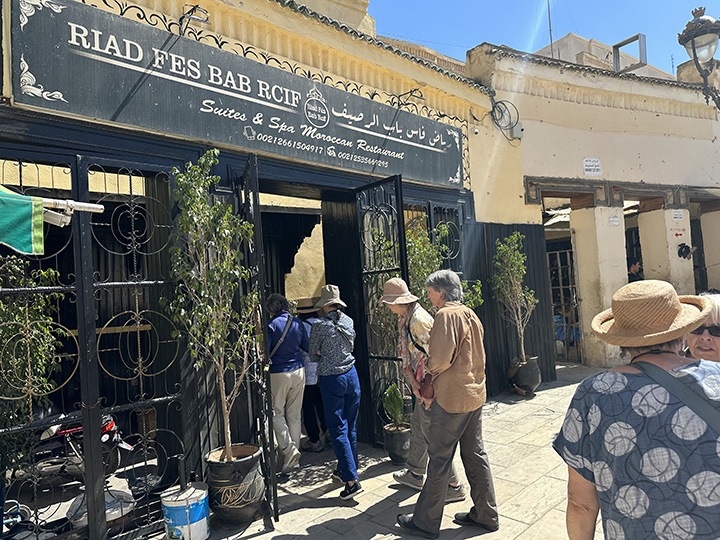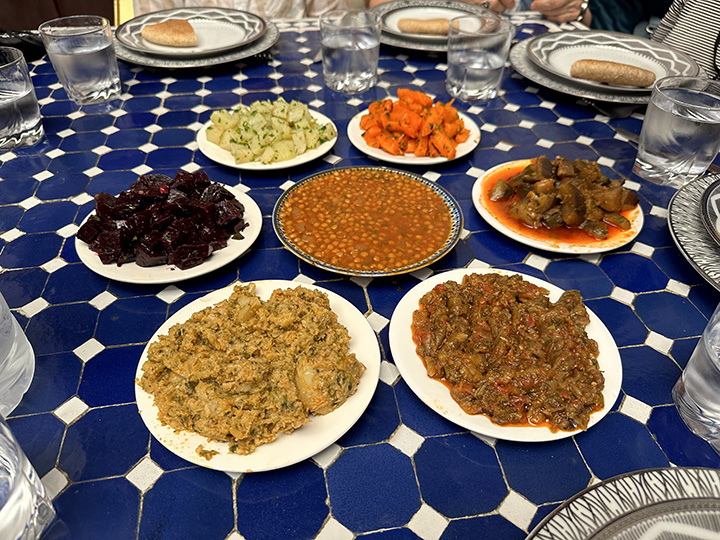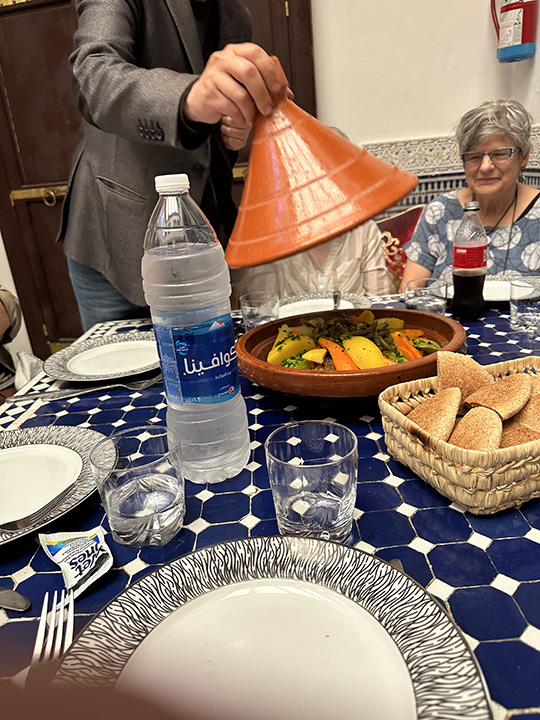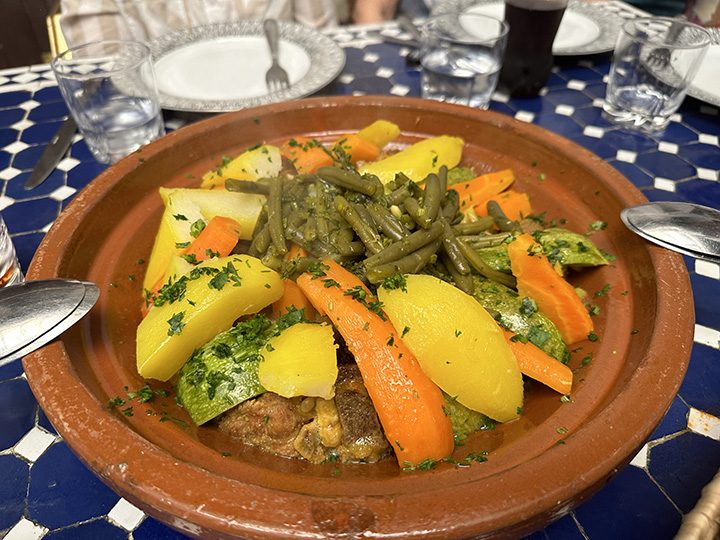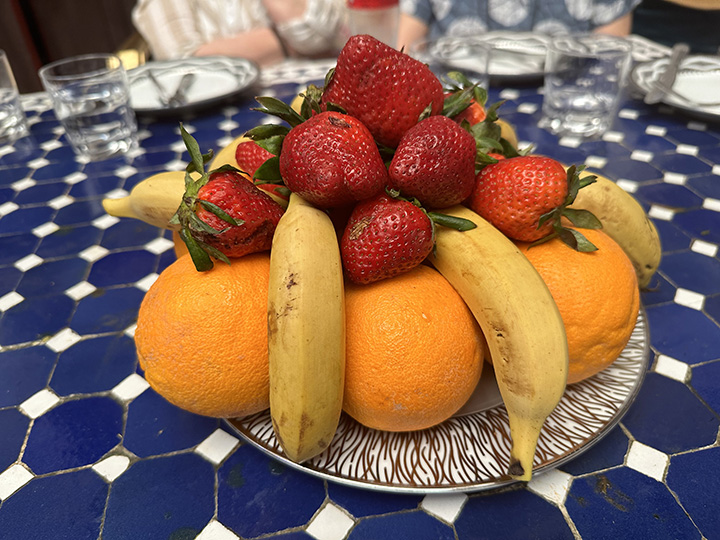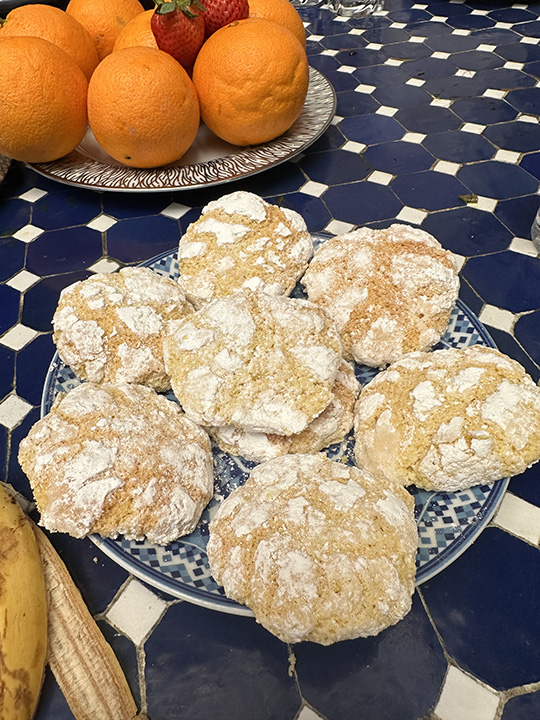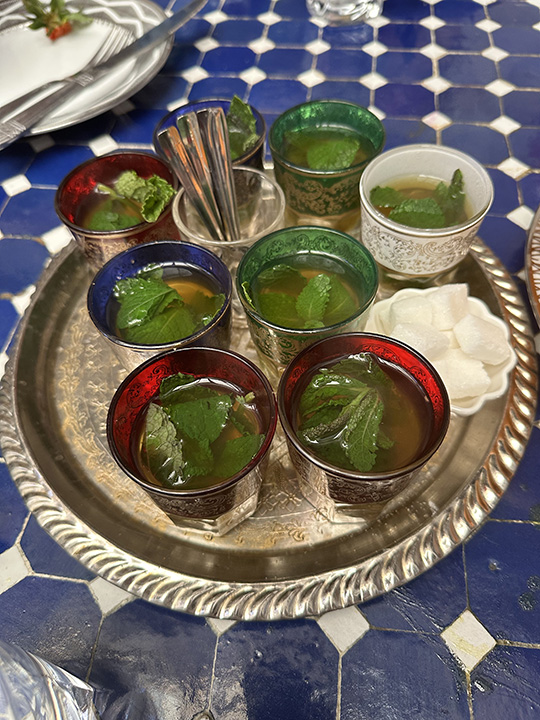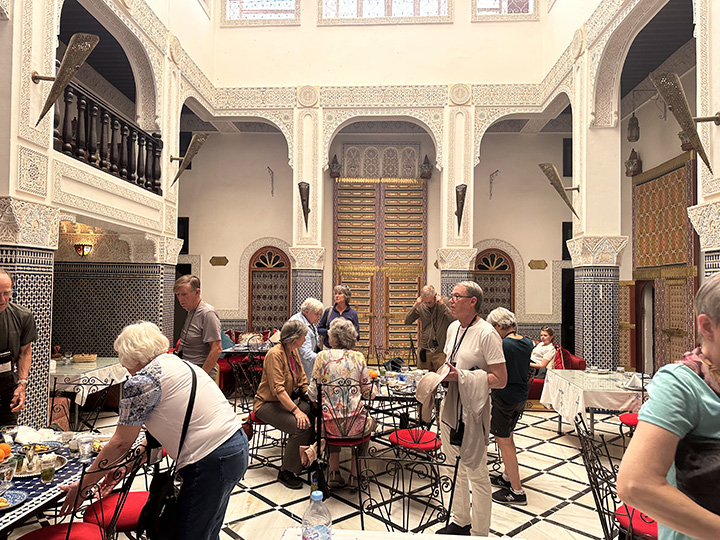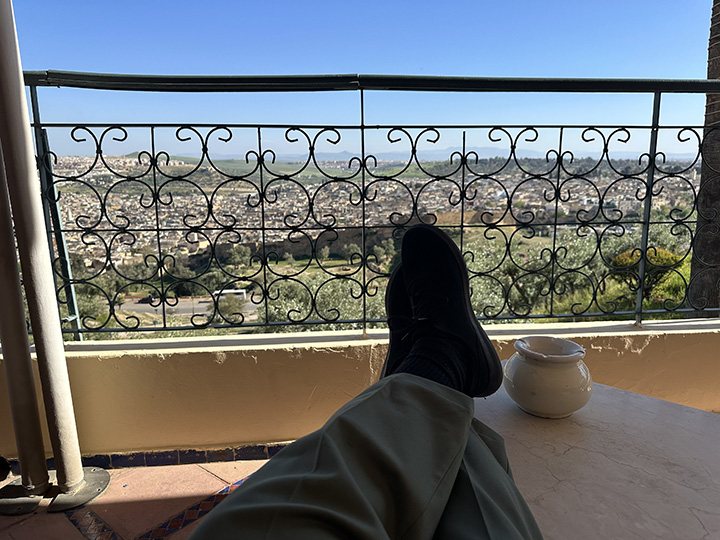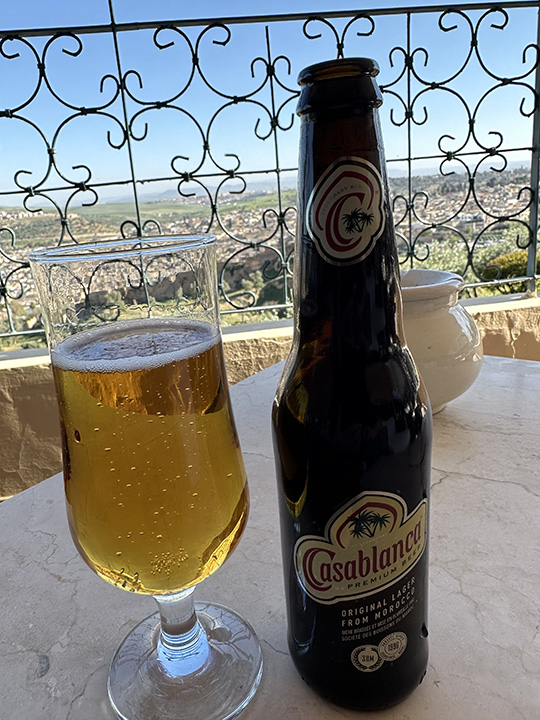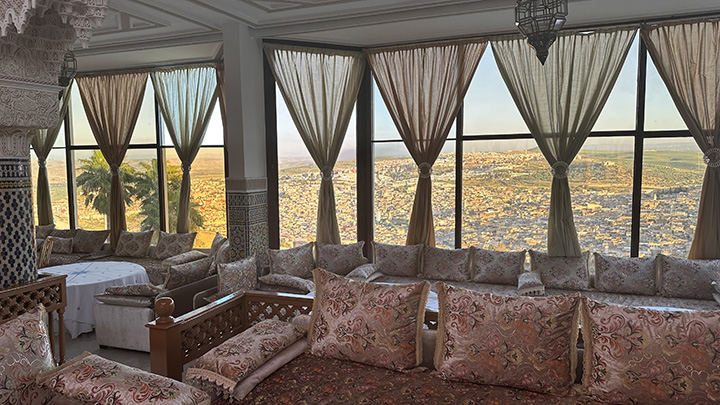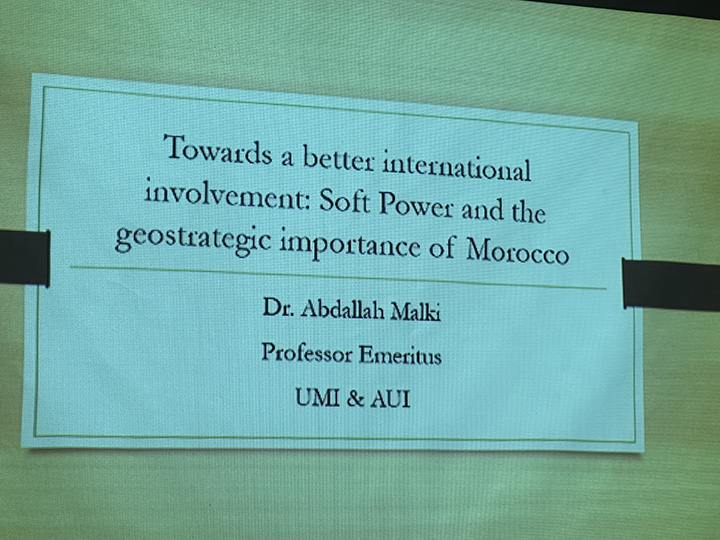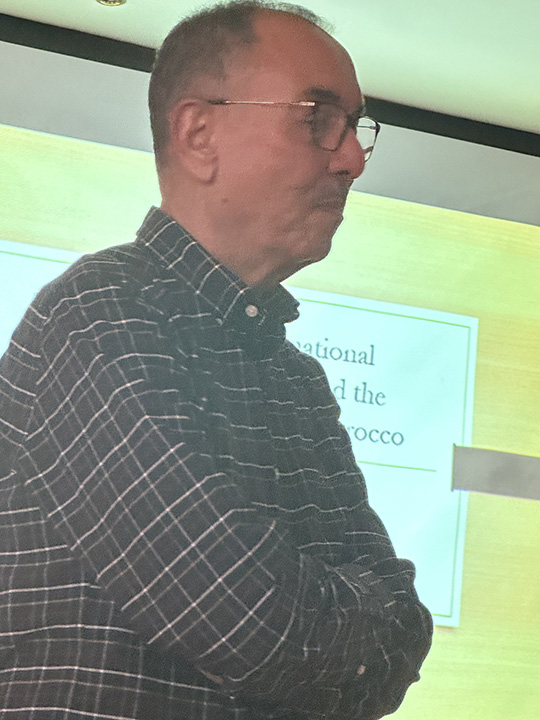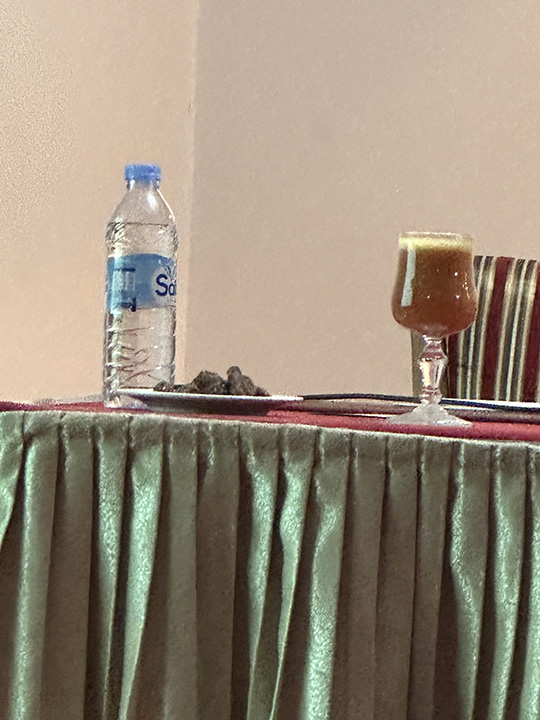|
Fez is an old city. Whereas most of the cities in Morocco have an old town called the Medina alongside modern development, that doesn’t work in Fez. Fez has an old town that dates from the 800s, a “new“ town that dates from the 1400s, and a Ville Nouvelle that has the modern stuff. Today we will explore the old Medina and the new Medina, learn how to make pottery, visit a school, visit a synagogue, and see a few other things along the way.
Dawn over Fez looked spectacular from my hotel room.
The scene is beautiful this way.
As well as that way.
Sometimes we have local guides when we are in a new city. This guy was good, but not as good as Nabil.
He is just a terrific guide.
Let’s go see the new city that dates from the 1400s.
It's over there somewhere.
Believe it or not, the government is spending lots of money to renovate the old new city and we're going to see lots of construction.
Just look at those pretty new doors.
There are more down that narrow street.
With a coat of varnish they really sparkle.
The graffiti artists are not so impressed. Actually, this graffiti was the only graffiti I saw all day. Our guide told us MAS is a rival soccer team.
Let's visit a synagogue.
Historically Fez was home to a large Jewish population, but what with one thing and another – – I never have been given an explanation that makes sense to me – – most of the Jews have left town to move to more friendly locations like Israel or the United States. We learned there are only about 80 Jews left in Fez today. This synagogue is just a museum now.
The Torah is behind that curtain.
The Road Scholars are taking it all in.
Our guide gave us a quick peek at the Torah.
The curtain has been moved aside.
And I got a better view of the Torah.
The trap door covers a shaft that leads down to the mikvah.
What’s that, you ask? Well it’s for the ladies of the congregation and it has something to do with menstruation and I stopped listening.
The walls had lovely decorative art.
Very nice. Too bad it's no longer in use for anything more than tourists.
Let's do some more exploring.
Our guide for the day kept us interested in the new old city.
We saw artfully decorated streets.
And the renovation continued.
Let's go see the gate to the royal palace.
The Royal Palace or Dar al-Makhzen, lit. 'House of the Makhzen', is the palace of the King of Morocco in the city of Fez, Morocco. Its original foundation dates back to the foundation of Fes el-Jdid ("New Fez"), the royal citadel of the Marinid dynasty, in 1276 CE. Most of the palace today dates from the 'Alawi era (17th-20th centuries). The vast grounds are home to multiple private structures, patios, and gardens, but historically also included administrative offices and government tribunals. Today, the most publicly visible parts of the palace are its main entrances at the Old Mechouar (to the northeast) and the highly ornate 20th-century gates at Place des Alaouites, near the Mellah (to the southwest). These are the 20th century gates.
Apparently tourists are allowed inside, but we aren't going in.
We're just going to look at the pretty doors.
The place looks pretty closed to me.
Now that's a nice pair of knockers. I thought about banging on the door and asking to see the Wizard.
The guide said the design incorporates the five pointed star of Islam, the six pointed star of Judaism, and the eight pointed star of something or other. I am remembering that he said star of Solomon, but the Internet says the star of Solomon is exactly the same as the star of David, which, by the way, I don’t see here no matter what they say.
If you can find a Star of David in all that you are a lot better at spotting patterns that I am.
The American Fondouk was founded in
1927 at the behest of Amy Bend Bishop, an American traveler who was
distressed by the poor conditions of the many working animals in Fez
Medina. At the time, there were 40,000 pack animals living in and
around Fez. As in any country dependent on subsistence agriculture,
Morocco’s draft and pack animals were worked hard by owners who were
often poor and uneducated. The animals needed good veterinary care,
improved husbandry and nutrition, and humane handling – both for
their own sake and for the sake of the families who depended on
their labor. Upon her return to the U.S., Mrs. Bishop contributed
$8,000 in memory of her mother as seed money to build a refuge for
these animals.
Now a little drive around the city.
We're looking for a pottery factory.
Here it is. This place makes pottery and is very happy to sell it to tourists.
And the Road Scholars, always happy to spend their money, wanted to learn all about it.
We have picked a new guide at the pottery factory. He's telling us how it all works.
First you mix up some really good mud.
Then you pound it into a mold.
And you use these tools...
To shape it into usable forms.
And you lay them out to dry.
Then you stack it all up. Well, this is just how they make tiles.
Pretty tiles.
Now what do we have inside?
They call it "throwing pots" but they don't really throw them -- they just spin them.
They use their feet to turn the wheel.
This guy has had lots of experience throwing pots.
They look plain when he gets through.
But when the artists have done their thing the pots are lovely.
Here's an artist at work.
This takes concentration and talent.
There are plenty of artisans here.
Careful, careful...
We're working on masterpieces here.
Intricate masterpieces.
And after lots of painstaking work...
You end up with stuff the tourist will buy. Yes, I bought something, a lovely tagine. I am having it shipped home and in a few weeks you can come by my place to see it. I would show it to you now, but I forgot to take a picture.
But now I have taken a picture of it sitting on a shelf here at home. Pretty, huh?
That's enough of the pottery shop.
We found an overlook. That's Fez out there.
And with the magic of an iPhone zoom lens we can see our hotel over there on the hill.
Now we are going to explore the old old city.
It's right down here.
The old old city needs wooden supports in some areas just to keep the walls from collapsing.
Our guide du jour tells us to be careful navigating these narrow streets.
You never know what you might encounter hurrying by.
Maybe even a donkey.
The road scholars are standing out of the way.
That's a fancy old door.
Now the Road Scholars are walking single file.
You have heard of narrow streets? I think they may have been invented here.
We have found a bakery!
That's little chunks of bread. Croutons, maybe?
Yum.
We got a free sample, an almond-based pastry, and it was absolutely delicious!
Working hard in a centuries-old cramped space.
Let's head out of the narrow streets for awhile.
They say that over there across the street there is a fresh food market.
I think we're on the right track.
Yep, that looks fresh all right.
And there's lots of it.
And it looks scrumptious.
Maybe yummy is the right word.
At first glance you might think pig, but remember where you are.
How can they sell their food without messing up their display?
He's spraying my hand with an orange blossom scent. Or something like that.
Pastries!
Oh boy -- amlou cacahuete. Composed of roasted and looted peanuts, Argan Oil and bee honey. Gourmet and fortifying to serve for breakfast or as a snack spread on bread. It also accompanies all kinds of pastries. I have no idea what "looted peanuts" are. Maybe they were stolen?
The Road Scholars have joined the crowd.
Laura is hanging on our guide's every word and Don isn't far behind.
Quite a selection, Mr. Butcher.
Our guide explained that we are looking at chunks of beef preserved in beef fat, olive oil, and maybe a few other things. He said the beef can last 10 years when prepared like this. Well, that is what he said.
It's a crowded market.
Lots of strange seafood.
The narrow streets are divided up into sections where everybody sells similar things. This section is devoted to colorful stuff like dyed fabric. You know those funny little red hats they call a fez? It turns out they bear that name because the red dye used to make them comes from the city of Fez. Or at least it did originally. How about that? Have I mentioned this before? Well it bears repeating.
Those are buttons. Yes, they are.
See?
You want art? Artists we got.
A canal flows through the market.
You want trinkets? We got trinkets.
Some street performers have found us.
This just goes on and on.
More trinkets.
But they don't make trinkets here. That guy over there is renowned in the region for his metalworking skills.
He's making a big pot.
Just watch him work.
The Mosque of al-Qarawiyyin, near the Suq al-'Attarin, or Spice Market of Fez al-Bali, is one of the world's oldest universities, and among the largest mosques in Africa. Founded as a private oratory in 857 AD by Fatima al-Fahri, the daughter of a wealthy Qayrawani immigrant, in the tenth century the mosque became the congregational mosque of the quarter of al-Qarawiyyin. The mosque is surrounded by madrasas, and was a major intellectual center in the medieval Mediterranean. Its prestigious academic reputation may have transcended religious divisions, if, as a popular tradition suggests, Gerbert of Auvergne (930-1003), who would become Pope Sylvester II and who is credited with introducing the use of zero and Arabic numerals to Europe, was once a student at al-Qarawiyyin.
The Almoravid ruler, Sultan 'Ali ben Yusuf expanded the mosque to its present size between 1134 and 1143. The courtyard's blue and white tile floor, marble ablutions fountain, and the two fountain pavilions, which recall the Court of the Lions at the Alhambra, were added by the Sa'did Sultan 'Abdallah ibn al-Shaikh (1606-1623 AD).
The architecture is lovely.
Islamic artists are not allowed to represent living things but their ability to create beauty from geometric shapes is unbounded.
And here, bounded by gorgeous geometric shapes, we have a tourist.
Make way for the Road Scholars.
Candies and pastries galore.
And enough herbs and spices to make Col. Sanders want to change his secret recipe.
All those displays of food have made the Road Scholars ravenous and once again Road Scholar has scheduled a special treat.
The first course was a big basket of bread along with plates of good stuff like beets and eggplant and carrots and lentils. The plate in the middle looks like it contains pork and beans but I guarantee it does not.
Opening the tagini reveals a main course of lamb chops and delicious vegetables.
Yummy vegetables.
And fruit.
And cookies.
And mint tea.
The Road Scholars are stuffed.
But not too tired to kick off their shoes back at the hotel.
And enjoy a taste of Casablanca on the patio.
But wait! The day isn't over yet!
We have an evening lecture.
He was from the local University and he gave a fascinating talk on the place of Morocco in world politics.
His presentation was late in the afternoon and as it is Ramadan he had been fasting all day. Even when he got hoarse while talking to us he could not have a sip of water. But Nabil set this little feast out for him so that when he finished he could have breakfast. Toward the end of his talk we heard a cannon fire, which in Fez is the traditional way the end of the day’s fasting is announced. He seemed to really enjoy his sip from that bottle of water.
|

